 By Pepper Parr By Pepper Parr
January 25th, 2019
BURLINGTON, ON
The works of that famous mime artist Marcel Marceau are lost to most of us.
 Trevor Copp as Marcel Marceau Trevor Copp is developing his skills and does an incredible Marceau performance. Copp doesn’t just do Marceau – he has extended the art of mime.
Marcel Marceau was a French actor and mime artist most famous for his stage persona as “Bip the Clown”. He referred to mime as the “art of silence”, and he performed professionally worldwide for over 60 years. He died in 2007.
Copp has picked up the art form and will be doing a performance on February 1st and 2nd at the
LIVELab ofMcMaster University; February 1 and 2 @ 7:30pm
Tix $15/$10 students. CLICK HERE for tix.
Directions/Parking Details – CLICK HERE
Copp has done this show before more than 8,000 people in the last year; audiences keep asking for more.
Reviews for TBT’s Mime Theatre
“A master of contemporary theatre….there is a sensitivity to the performance, an indefinable sense of risk taking that signals the true artist”
– Gary Smith, The Hamilton Spectator
“…inspirational cross-training for the soul… there is a deep seated need for this kind of physical art that people don’t even realize they have anymore. In the age of Netflix and downloads, return to the campfires of our primitive ancestors and feel how theatre first stirred our souls. And as a bonus, feel the incomparable magic of the man in the box bit done by someone who studied at the Marcel Marceau School in Paris and clearly knows what he’s doing.”
– Diane Lachapelle, Apt. 613 Blog
“He moves with beautiful fluency…simply too creative for words. Highly skilled….a fresh fusion between acting and modern dance”
– View magazine
Searching for Marceau is the story of a budding young artist trying to make sense of his two fathers: the real one raising him and the far away Marcel Marceau. The imaginary and the real battle in this theatre/mime piece that reinvents Marcel Marceau’s Mime tradition for the 21st Century.
Some examples of a Copp performance – short clips
Movement study: a bird flapping wings.
The old standard. I still get more requests for this than anything.

 By Staff By Staff
January 25th, 2019
BURLINGTON, ON
The Halton District School Board is hosting a two-day conference this spring where professionals, parents/guardians and community will learn about an educational approach for Autism Spectrum Disorder (ASD).
The conference, called The SCERTS Model: A Comprehensive Educational Approach for Children with Autism Spectrum Disorders and Related Developmental Disabilities, will be held Wednesday, April 17 and Thursday, April 18, 2019 at the Burlington Convention Centre (1120 Burloak Drive, Burlington).

The conference features guest speaker Dr. Barry Prizant who is recognized as one of the leading scholars in autism spectrum disorders and communication disabilities. He has more than 40 years experience as a researcher and international consultant for individuals with autism and related disabilities. He is a certified Speech-Language Pathologist, an Adjunct Professor at Brown University and director of a private practice.
Formerly, Prizant was a Professor of Communication Disorders at Emerson College and Associate Professor of Psychiatry in the Brown University Medical School.
Mark Zonneveld, Superintendent of Education for the Halton District School Board is the lead on this project. The outcome for him is to “help our school and parent communities better understand Autism Spectrum Disorder (ASD) and how we can effectively assist youth at school and at home.”
This presentation will provide an introduction to the SCERTS Model (Social Communication, Emotional Regulation and Transactional Support). The Model is a comprehensive evidence-based framework for prioritizing goals and implementing practices that focus on the core challenges in ASD: Social Communication, Emotional Regulation, and providing Transactional Support for children with ASD, and related social-communicative disabilities.
The SCERTS Model is a flexible and individualized approach that includes focusing on learning functional skills in everyday activities and is based on the unique learning style of persons with ASD.
In this workshop, assessment and intervention issues will be addressed for children with a wide range of developmental abilities and ages, including preverbal and verbal individuals, from preschool through elementary, middle, high school ages and adult services. Particular emphasis will be given to the core challenges faced by students with ASD and related abilities by emphasizing the interface between social, emotional and communication issues from a clinical and educational perspective.
The SCERTS Model has been implemented in more than a dozen countries in programs ranging from Early Intervention, school-age services and adult services.
Cost
Early Bird Registration (Received before Feb 15, 2019)
$395.00 (Includes Lunch)
Regular Registration (Received after Feb 15, 2019)
$425.00 (Includes Lunch)
For more information about the SCERTS conference and/or to register, click here.

 By Pepper Parr By Pepper Parr
January 24th, 2019
BURLINGTON, ON
It was an issue that sort of crept up on the public.
Someone caught Premier Doug Ford telling a group of developers that he was prepared to open up some of the Greenbelt so that developers could build much needed affordable housing.
It was music to the ears of the developers who would take advantage of the opportunity to build high end homes in a rural setting – there wasn’t a hope of there ever being any affordable housing in these prime building sites.
The Premier’s comments about affordable housing were a laughable ruse to a public that is a little less gullible than it was the day they elected him seven months ago..
The municipalities pushed back hard and have been able to convince the provincial government to take out a section of proposed legislation off the table.
The province announced earlier this week that it would pull the controversial Section 10 of the Proposed Bull 66 that is now before the Legislature.
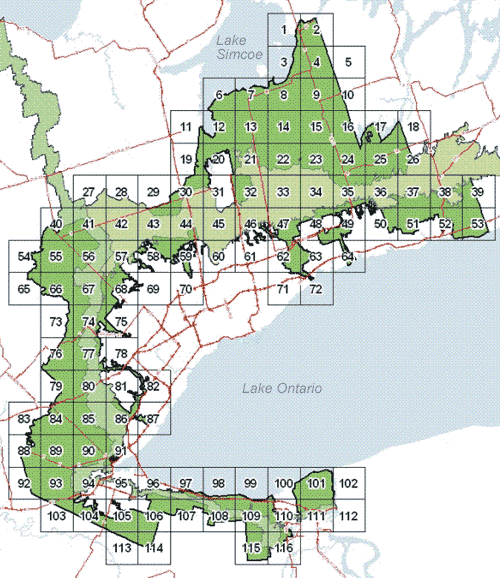 The Greenbelt created in 2005 – eye candy for the developers, lifeline for the taxpayers. It was not a simple task, Burlington, along with a number of other municipalities that touched on or were part of the Greenbelt created in 2005.
Burlington submitted comments as part of a response to the legislation tabled on December 6, 2018, by the Provincial Government, referred to as Bill 66, Restoring Ontario’s Competitiveness Act, 2018.
If passed, the legislation would have allowed municipalities to, with the Minister’s consent, pass “Open for Business’” zoning bylaws. These bylaws would not be bound by existing legislation, such as the Clean Water Act, 2006 or the Greenbelt Act, 2005.
For a city such as Burlington, where half our land is rural and located within the Greenbelt, the tools proposed in this legislation were of great concern and do not address the barriers the City is facing regarding economic development.
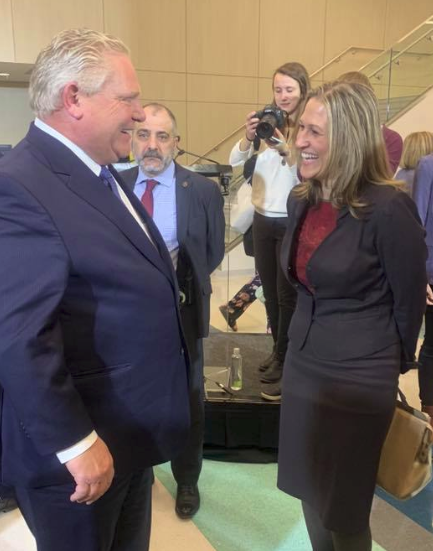 All smiles when Mayor Meed Ward met with the Premier while he was on a hospital tour – no word on whether or not she advised the Premier to keep his hands of the Escarpment. Burlington is already “open for business” with over 400 acres of employment land sitting vacant and available.
Mayor Marianne Meed Ward said: “Residents have overwhelmingly expressed support to protect our Greenbelt and public safety in the Clean Water Act. We will do that. We have sent a clear message to the province; I have written to Steve Clark, the Minister of Municipal Affairs and Housing, and Halton Regional Council already unanimously approved a resolution confirming that we won’t compromise public safety or our Greenbelt to be open for business. We have a large supply of suitable land available and are ready to work with businesses.”
Burlington made its comments for submission to the Province regarding Bill 66 available to the public on January 18th.
The resolution approved at Halton Regional Council on the legislation was included in the Regional Council meeting minutes from January 16, 2019.
In promoting the legislation to the municipal sector Steve Clark, Minister of Municipal Affairs and Housing said: “Our government is committed to making it faster and easier for municipalities in the region to plan for growth, increase housing supply, attract investment, and create and protect jobs. That is why we are proposing changes to the Growth Plan for the Greater Golden Horseshoe, 2017 and its transition regulation.
“Given the rising number of people who will live and work in the Greater Golden Horseshoe in the next 20 years, the Growth Plan provides a long-term framework for growth. It aims to:
• Increase and promote economic growth, reduce congestion and provide residents easy access to businesses and services
• Build communities that maximize infrastructure investments, while balancing local needs for the agricultural industry and natural areas
 Does this look like a site for affordable housing? The Minister added: “We have heard that planning for growth in the Greater Golden Horseshoe Region is needed. However, we have also heard that there are some issues with how best to implement the Growth Plan. The proposed changes build on feedback that the Ministry of Municipal Affairs and Housing heard from the business, research and development sectors, municipalities, and others during engagement sessions last fall.
The proposed changes respect the ability of local governments to make decisions about how they grow. The province will maintain protections for the Greenbelt, agricultural lands, the agri-food sector, and natural heritage systems.
Helen Walihura, Government Relations Specialist and part of what city hall staff call the Burlington Leadership Team, wrote much of the document Burlington submitted. It is quite detailed and is a recognition of the fact that the province is always looking for ways to make changes to MORE HERE
 Burlington managed to beat back the attempt to have a highway run through Kilbride and Lowville. It was the highway that the Ministry of Transportation wanted to push through Kilbride and Lowville and have it join up with highway 407.
City of Burlington Comments on Bill 66, Restoring Ontario’s Competitiveness Act, 2018
On Dec. 6, 2018, the Provincial government introduced Bill 66, the Restoring Ontario’s Competitiveness Act, 2018. This omnibus bill is meant to “eliminate red tape and burdensome regulations so businesses, can grow, create and protect good jobs.” The proposed legislation includes 32 actions across 12 ministries. Of particular interest, is the proposed new Open-for-Business planning tool and the new regulations under the Planning Act related to the tool.
The Ministry of Municipal Affairs and Housing invited comments on the proposed legislation via the Environmental Registry under three separate consultations.
• ERO 013-4125 – Proposed open-for-business planning tool
• ERO 013-4239- New regulation under the Planning Act for open-for-business planning tool
• ERO 013-4293 – Bill 66, Restoring Ontario’s Competitiveness Act, 2018.
Comments for all three consultations were required by January 20th, 2019.
City of Burlington staff reviewed the proposed legislation and submitted the following comments to the Province.
Proposed open-for-business planning tool (EBR Posting 013-4125)
City of Burlington staff does not support the creation of an open-for-business planning tool as proposed, for the following reasons:
a. The tool undermines the city’s goals to achieve coordinated and sustainable planning, as delivered through the application of the Provincial Policy Statement, Growth Plan, and Greenbelt Plan. Allowing major employment uses in areas not intended for such uses will fragment Agricultural Systems and Natural Heritage Systems and could lead to a creep of land use pressures to introduce residential, ancillary and other supportive uses to support the major employment use;
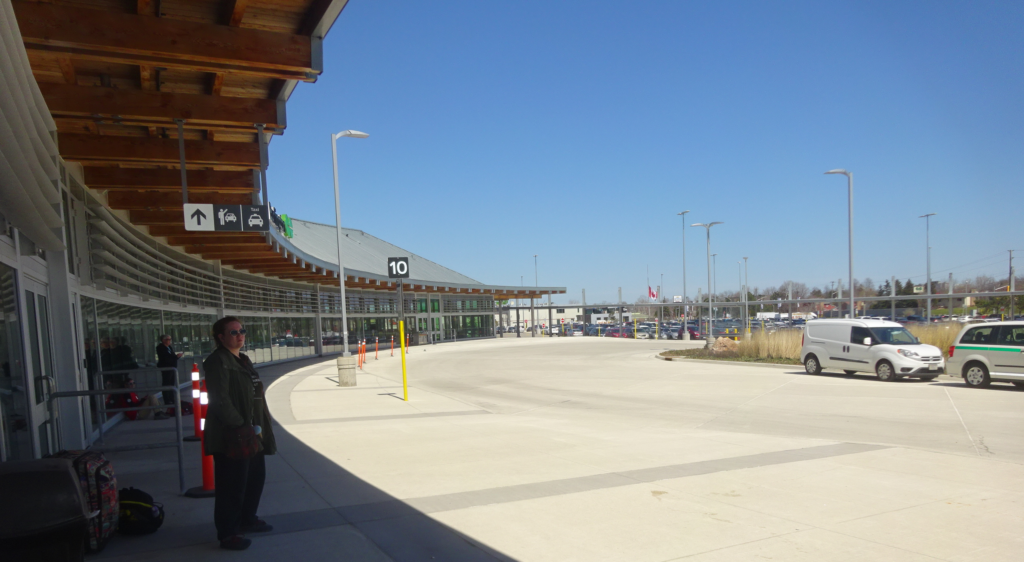 The Burlington GO station is steps away from a major five tower development on Fairview that is part of the new mobility hub that covers all of the property on the north side of Fairview east to Guelph – which is where the city wants to see new development take place – affordable housing fits into spaces like this. b. The tool undermines provincial investments in infrastructure, such as the transit projects identified in the Metrolinx Regional Transportation Plan. The tool could also undermine Regional investments in infrastructure. Major employment uses should be directed to locate within existing urban areas that are supported by transit and other infrastructure investments, such as near Major Transit Station Areas. Locating major employment uses within the Greenbelt Plan area, and other areas not intended for or compatible with such uses will result in the inefficient use of existing infrastructure and contribute further to traffic congestion;
c. Businesses want certainty and clarity regarding land use permissions. The tool introduces uncertainty in the planning framework that could increase land speculation and contribute to affordability challenges;
d. The tool contradicts the climate change goals articulated in the Province’s draft Environmental Plan, by potentially increasing the greenhouse gas emissions associated with sprawl, and the potential for long term increased costs in environmental remediation and the impacts to water resources and drinking water; and
 Did Grow Bold mean that we were open to everything? Not with the new council elected last October. e. The open for business planning tool will create a competition amongst municipalities that rewards those that will accept the weakest planning, environmental and health and safety regulations. The province should ensure that all municipalities are raising the bar to achieve quality and sustainable developments, to ensure health and safety and to reduce long term cost impacts that would result to address environmental issues and to maintain unsustainable investments in infrastructure.
f. Eliminating the requirement for notification and consultation with the community, other agencies or municipalities may speed up the approval process, but will not necessarily result in good decisions or faster completion of a development. Residents want and ought to be involved in planning decisions that will impact the communities they live in. Local planning decisions that will impact the service delivery of others cannot be made in isolation. Not including Halton Region in Burlington planning decisions where new regional services are required will not result in jobs coming to Burlington faster, in fact, bypassing the Region could result in delays and additional costs.
g. Allowing major trip generators (such as employment developments), to by-pass council approved transportation policies and directions will mean that municipalities will be responsible for meeting conditions that developers would usually be responsible for. For example, if a developer asks for relief in the amount of parking which they are required to provide, and this relief is granted through this proposed policy, only to realize once the project is constructed and operating that there are insufficient parking spaces. The overflow parking becomes an issue the municipality must address.
Instead of an Open for Business Bylaw, please consider the following tools:
a. Tools to incent the creation of innovation districts located near Major Transit Station Areas and other areas that are serviced by transit. Innovation Districts are a type of business and or industrial district to attract and promote clusters of private and public-sector firms and organizations engaged in the development of new products, materials, services and knowledge . An Innovation District at its core must be driven by existing assets and an economic development strategy. A Provincial program to support and build upon existing businesses and organizations within a municipality would be a more prudent approach to using existing specialization and resources. Such a program could include support for creation of economic development strategies for local Innovation Districts;
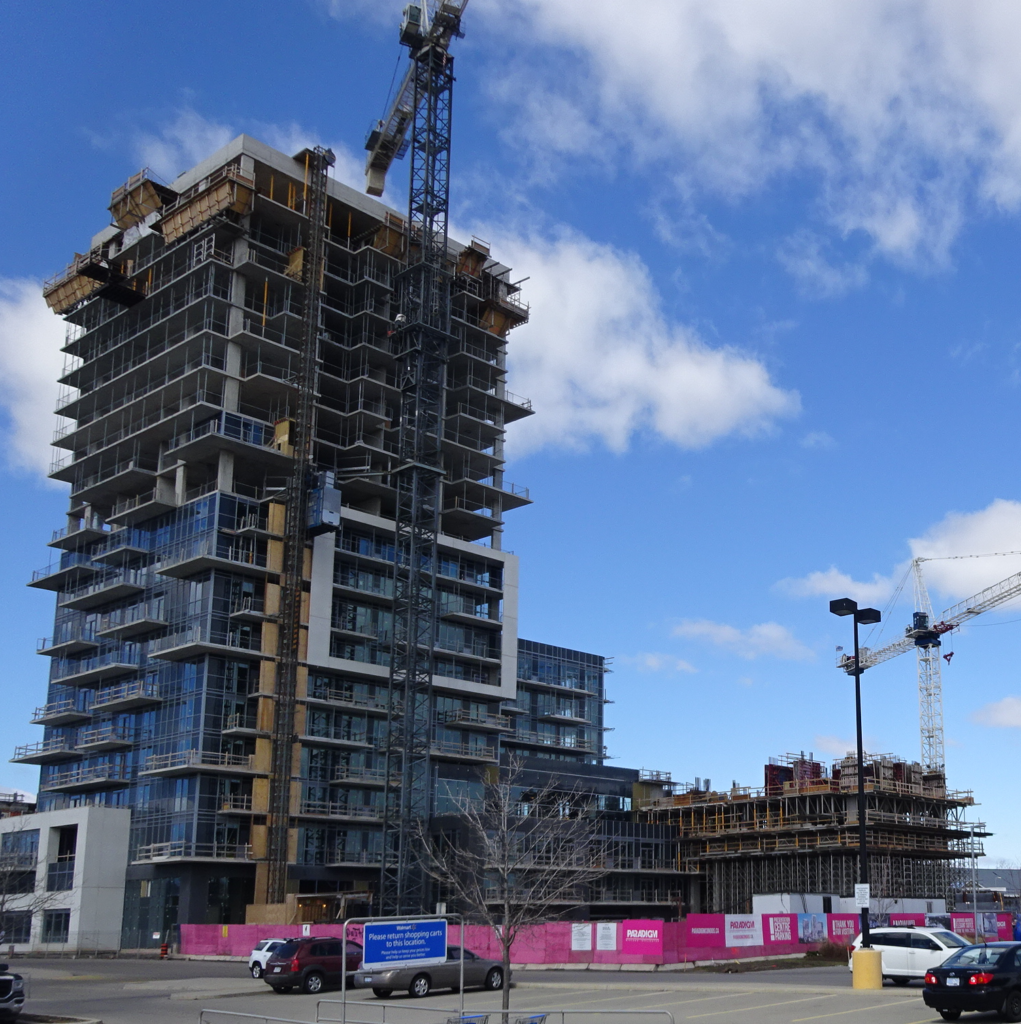 The first of the five tower development is about to be occupied. All the property to the east is part of a new mobility hub that will encourage higher density growth. b. The tools proposed in the open-for-business planning tool do not address our barriers to economic development. An example of a barrier to the development and redevelopment of employment lands is the timely and coordinated issuance of MTO permits. Approximately 80% of the City’s employment lands are within the MTO development permit area. Addressing this barrier would assist in the timely development of serviced and transit oriented employment lands; and
c. The province should consider the use of the MZO tool as an alternative. This tool already exists at a provincial scale. The Planning Act could be amended to expressly identify the attraction of a major employment and economic growth opportunity as a matter of provincial interest. Consideration of these types of uses should be done at a provincial scale to ensure coordinated planning and use of infrastructure.
The following items require more clarity to understand how the tool will be implemented:
a. What is the evidence/data that demonstrates that these sections of the Planning Act are the barriers to locating major employment uses?
b. Please define major employment and economic growth opportunities.
c. What are the prescribed criteria referenced in Section 34.1(2) of the Planning Act?
d. How does the use of this tool apply to Upper Tier vs. Lower Tier municipalities? Are there criteria for determining what is of Regional interest or local interest?
New Regulation under the Planning Act for open-for-business planning tool (EBR Posting 013-4239)
1. Please see EBR Posting 013-4125 above for additional feedback from the City Burlington.
2. In order to provide all feedback a copy of the regulation should be provided.
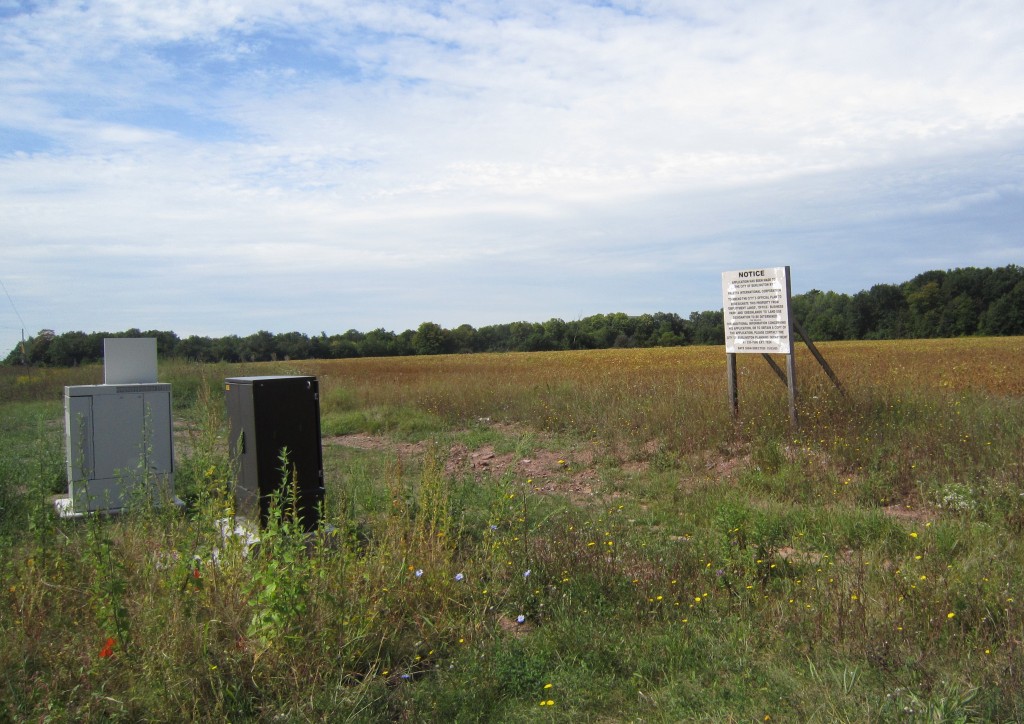 Burlington has a lot of land that is “open for business” The location on Mainway next to Burloak is zoned commercial, spitting distance to the QEW, minutes from downtown – owner wants to rezone and make it residential. 3. The regulation notes that evidence is required to demonstrate the minimum job creation threshold . This presents implementation challenges. What evidence is acceptable? How do you ensure the proposed jobs are delivered and remain in place for a significant amount of time? Are there penalties if the proposed jobs do not materialize? Will there be any recognition of the differences or importance of either basic or non-basic industries?
4. The regulation indicates that residential, commercial or retail cannot be the primary use. This language could actually introduce mixed uses, particularly residential which appears to be in conflict with the main objective of the open-for-business tool.
5. Any proposed regulation should be specific to not permit recreation or institution uses.
Burlington, along with the other three municipalities in the Region are going to have to be constantly vigilant and ensure that what makes Burlington unique is left alone.

 By Staff By Staff
January 24th, 2019
BURLINGTON, ON
In a note to residents in Ward 5 who are on the Council member’s mailing list Paul Sharman sent the following:
“As you may remember from the previous Open House letter that was mailed in July 2018, the City of Burlington received applications from Burlington Retail Portfolio Inc. to re-designate and rezone the properties located at 5353 Lakeshore Road (Lakeside Plaza).
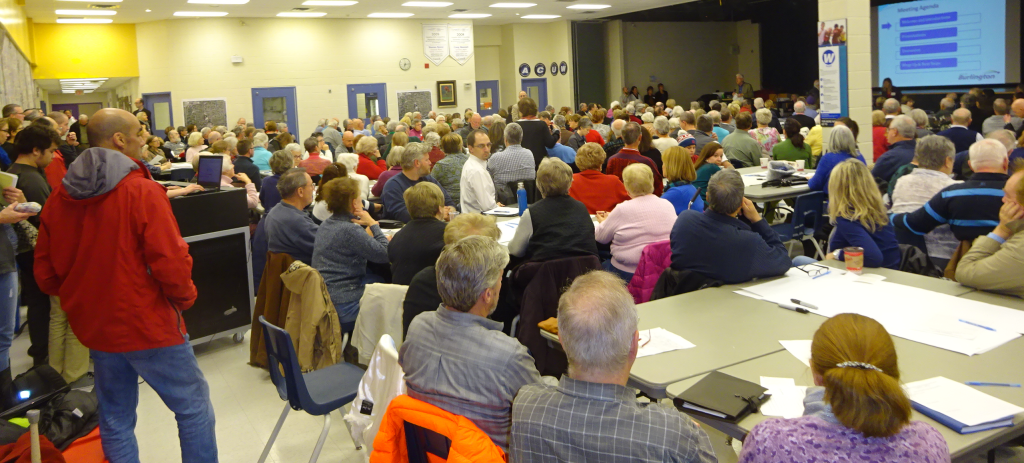 It was standing room only at the Lakeside Plaza visioning event in 2015. “The purpose of these applications is to permit a mixed use redevelopment with building heights ranging from one to eighteen storeys. The applications propose 900 new residential units, 2,700 square metres of office space and 11, 955 square metres of service commercial and retail uses with 1350 parking surface and underground parking spaces. Access will be maintained from Kenwood Avenue, Hampton Heath Road and Lakeshore Road.
“The property is currently zoned ‘Neighbourhood Commercial (CN1-63)’. According to the City’s Official Plan, the subject properties are designated Neighbourhood Commercial.
Sharman then advises his constituents that “there will be a Statutory Public Information Meeting; residents are invited to attend and learn more about the proposed Official Plan amendment and Zoning By-law amendment applications for 5353 Lakeshore Road. This meeting will take place on: February 12, 6:30 pm; City Hall Council Chambers, Level 2.
“This report does not include a recommendation about the application at this time. The purpose of the information report is to update all members of Council about the development proposal. The report will be available on the City’s website at www.burlington.ca/calendar by searching for the meeting date for the Planning and Development Committee. A copy of the report can also be picked up at the City Clerk’s Department on the main level of City Hall.”
In his most recent report to his constituents Councillor Sharman adds:
 Former Mayor Rick Goldring on the left talking to Cynthia Zahorak and the developer at the Lakeshore Village Plaza visioning event in 2015. “The applicant is in control of what they chose to apply for, not me and not Council. At this stage the applicant heard what members of the public had to say at open house meetings in July and August. I understand the City has not received a modified application.
“Meanwhile, the review period of 210 days has passed, and the City needs to move the file along. Hence there will be a Statutory Public Meeting on February 12.
“Council will not have the ability to make any decisions on the application until staff prepare a recommendation report, sometime in the future. We will learn in the course of time whether the applicant has chosen to reduce the scale, density, design and parking numbers.
“If you have any questions about these applications, please contact me.”
That’s the official word from the ward Councillor. Paul Sharman appears to have taken a pass on the opportunity to comment on the rich background and his personal involvement in the development of this project.
Sharman was an advocate for something in the way of development in the east end in a Plaza that had certainly seen better days. He went into Toronto to try and meet with the people who paid the taxes on the property but was able to get beyond the receptionist – which for Paul Sharman is surprising.
What is missing in the information Councillor Sharman provided is his view on the development. Sharman has never been known for hiding his views in the past. He is outspoken, direct, at times bombastic – he seldom ‘shilly shallies’.
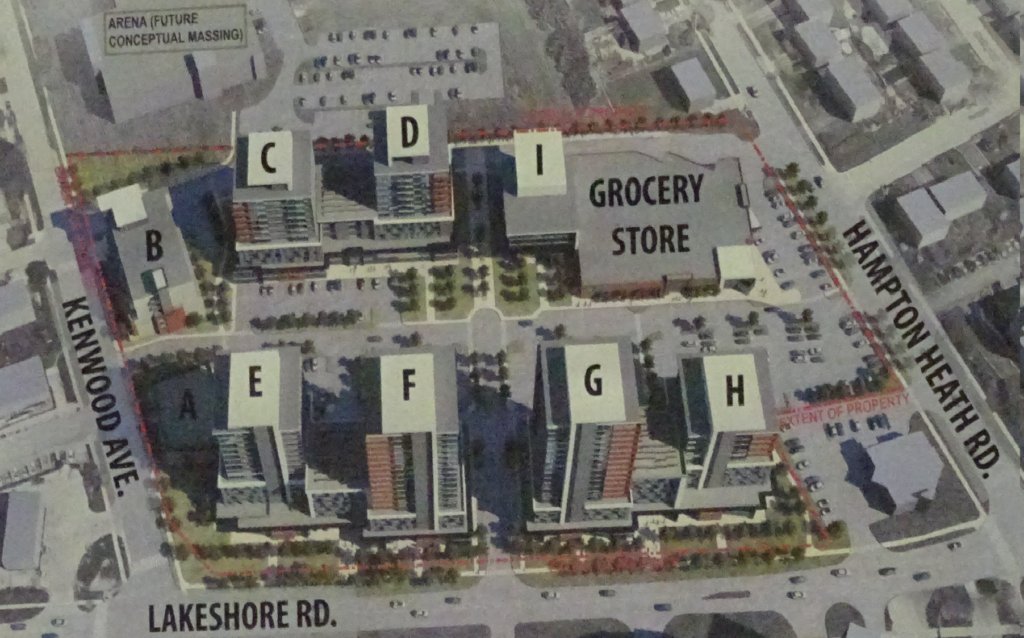 Lakeside village plaza proposal The development is huge in scale. It brought out hundreds of people who gathered in a small space during the summer to look at the architectural renderings and ask city staff and the developer’s consultants questions.
The development has a long history. Councillor Sharman wanted to see something done with a Plaza that was in pretty sad shape – it was well past its prime.
During a Council meeting when Jeff Fielding was city manager Sharman informed his colleagues that he had tried to meet the owners at their offices in Toronto – wasn’t able to get past the receptionist.
 There was a worried looking Paul Sharman at the first public showing of what the developer had in mind for what was now being called the Lakeshore Village Plaza Sharman felt there was an opportunity to merge the small arena and park to the north of the development and pull it together with the Burloak Park that was being upgraded.
An architect provided some exceptional drawings showing what could be done.
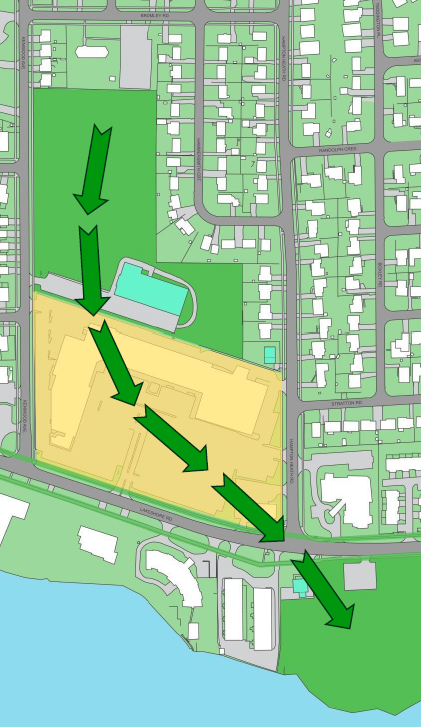 Some of the original thinking by the architects had the park and arena to the north of the plaza tied into the development and the BurlOak park to the south. Pictures of meet here
City staff that participated in the July-August public display of the developer’s plans did say, off the record, that the development the city was looking at was not quite what they had in mind.
At that point the city did not have a completed application to act on.
The developer was testing public reaction – and they certainly got an earful.
 City staff were out in force at the Lakeside Plaza visioning exercise. The developer was in the room but does not appear to have heard what the citizens had to say, Community concern became an election issue – the only thing that kept Sharman in office was the number of candidates that ran against him. With four people running against him Sharman was able to split the vote and get returned to city hall; where he has yet to comment on the size and scale of a development that will certainly change the look, feel and traffic flow in the community.
Expect some vigorous community reaction to this one at the Statutory meeting scheduled for February 12th.

 By Ray Rivers By Ray Rivers
January 23rd, 2019
BURLINGTON, ON
There was a time when butter was bad and hydrogenated margarine the cats’ meow. But that was so yesterday.
Then we were being told that meat, eggs and fat were full of cholesterol and bad for us. At least until Mr. Atkins came along and the Paleo crowd showed up. And when anyone consulted the official Canada Food Guide, it seemed that they were just too busy promoting Canadian farm produced dairy and meat products to be trusted.
 The 2019 version of the Food Guide There are thousands of recipe books out there. And to distinguish themselves and keep us from dying of nutritional boredom they guide us to cook our food every which way from Sunday, and to hurl a host of additives into our food. There was red dye #2 and saccharin which were proven to give you cancer. We now know that sugar has been linked to diabetes, and lots of salt is a recipe for heart disease. And God knows what ‘liquid smoke’ must do to your body.
Where better to learn how to prepare healthy food than by watching those colourful chefs on the food channel, you’d think? My favourite anti-hero is Canada’s John Catucci and his ‘You Gotta Eat Here’. His travelling food show features some of the most over-salted and sugared, deep-fried dishes known to man or woman.
Catucci’s show, and its ilk like Carnival Eats, and Guy Fieri’s ‘Diners, Drive-ins and Dives’ are the anti-christ, the enemy of healthy eating. It may take more than Canada’s Food Guide to move us out of these greasy spoons and back into our own kitchens. But it is a start.
The Guide has traditionally been part of the school curriculum and is intended to be promoted by health and fitness professionals. And that should include food served at daycares and schools, recreation centres, workplaces and health-care facilities. But don’t count on it. Hot dogs, hamburgers, donuts, and all that other stuff we affectionately call junk food, are pretty regular fare when kids eat out.
My column is usually about politics. So why food and a food guide? Well, like everyone else I like food, healthy food. I even wrote and produced a play on the topic in the Hamilton Fringe festival one year.
Previous guides have always been a compromise between nutrition and supporting our dairy and animal farmers. You can find a flank steak and some skim milk in a few of the recipes in the new Guide but water is now the new preferred meal time beverage. And that pretty well sums up the new Guide.
 Meat is the most inefficient source of protein we can consume. No doubt the dairy and cattle farmers will be unhappy about what they’ll see as a move by a federal government agency to convince folks to eat less of their output. Albertans might even say this is more proof that Justin Trudeau is trying to destroy their livelihood, much like his father tried to do to the province’s oil men and women. Of course that is nonsense but there is a commonality between red meat and oil.
It’s how these products affect the environment and climate change in particular. Cows and other ruminants release huge amounts of greenhouse gases (GHG) when they digest their food. And meat is the most inefficient source of protein we can consume anyway. It requires far more land and water than soybeans per measure of protein, for example. And animal off-gassing is a leading source of GHGs – as we see particularly in places down under, where the Hobbits dwell.
The new guide recommends eating lots of fruit and vegetables, but otherwise stayed away from its past practice of identifying necessary food groups. It includes a number of healthy food recipes and openly encourages Canadians of all ages to get into their kitchens and start cooking. And there is a big pitch to bring the next generation into the time honoured practice of making our own meals, and by-passing the drive-thru.
It has taken three years to put this fairly simple guide together and must have cost a bundle. The authors consulted almost thirty thousand Canadians and every food agency in the country. Oh sure food guides and recipe books are a bit of reach back into nostalgia in this day of five minute delivery, one might think.
But whether you still living in a ‘Leave it to Beaver’ era kitchen or have outfitted yourself with the best of todays space-age culinary hardware, cooking your own food is fun and more economical than the alternative. The reality is that only one in five Canadians cook every day and some would say that alone is unhealthy.
 There is an epidemic of obesity in this country; just 29% of us have a healthy body weight. There is an epidemic of obesity in this country and the number one culprit is fast food. Anyone who hasn’t, should watch the epic documentary ‘Super Size Me’ (below). Poor diet is a leading risk factor for death in Canada. So the federal government has taken a somewhat passive stab at that issue with its new Canada Food Guide. And every Canadian should have a copy in their kitchen, and maybe even to show to their children at bed time.
I have to run now as my veggie chilli is just coming to a boil….
 Ray Rivers writes regularly on both federal and provincial politics, applying his more than 25 years as a federal bureaucrat to his thinking. Rivers was once a candidate for provincial office in Burlington. He was the founder of the Burlington citizen committee on sustainability at a time when climate warming was a hotly debated subject. Ray has a post graduate degree in economics that he earned at the University of Ottawa. Tweet @rayzrivers Ray Rivers writes regularly on both federal and provincial politics, applying his more than 25 years as a federal bureaucrat to his thinking. Rivers was once a candidate for provincial office in Burlington. He was the founder of the Burlington citizen committee on sustainability at a time when climate warming was a hotly debated subject. Ray has a post graduate degree in economics that he earned at the University of Ottawa. Tweet @rayzrivers
Background links:
Canada Food Guide – More Food Guide – Food For Thought – Super Size Me –

 By Pepper Parr By Pepper Parr
January 23rd, 2019
BURLINGTON, ON
City Council met on Monday in the Great Room at the Paletta Mansion.
It was a closed session with two presentations being made:
A Workshop presented by Mike Galloway, CAO, Town of Caledon, on Governance for Elected Officials and Senior Management.
There was a second Workshop presented by Jeff Abrams and Janice Atwood-Petkovski, Principles of Integrity on Code of Conduct and responsibilities of the Integrity Commissioner.
The province requires all municipalities to have a Code of Conduct in Place and an Integrity Commissioner that the public can turn to should anyone feel that the elected officials and the appointed Staff are not complying with the Code of Conduct.
Burlington had problems putting a Code of Conduct in Place. Former City Manager James Ridge wasn’t able to get the 2014-2018 city council to agree on a Code of Conduct and ended up having to use much of the boiler plate document the province provided.
Marianne Meed Ward, now the Mayor, was a huge champion for a Code of Conduct – but she was never able to convince her colleagues to come up with something they couldn’t slide around.
 The session on Monday was the first opportunity the new Council got to see what it was that they had to live by. The session on Monday was the first opportunity the new Council got to see what it was that they had to live by.
Burlington, along with the Region and all the other municipalities in the Region agreed to hire the same form to serve as the Integrity Commissioners for everyone. Their contract started last September – it took them a number of months to get organized and deal with any complaints or concerns.
The Integrity Commissioner is hired by the municipality, paid by the municipality and reports to the municipality.
The city web site had next to no information on the new Integrity Commissioners.
The Gazette had to reach out to other municipalities to get some background on Abrams and Atwood-Petkovski.
On October 1st, 2018 the Gazette filed a formal complaint against then ward 6 Councillor Blair Lancaster for making public information that she learned of in during a Closed Session of city council.
The details of the complaint and the response we got from the Integrity Commissioner is instructive.
Our letter to them:
Jeffrey A. Abrams, Co-Principal
Principles Integrity
Toronto, ON
October 1, 2018
Dear Sir:
I wish to file a complaint with the Integrity Commissioner that city of Burlington has retained.
I am the publisher of the Burlington Gazette, an online accredited newspaper that has been publishing since October 2010.
 On September 20th, Ward 6 Councillor Blair Lancaster posted a note on the Facebook page of what is known as Burlington News. On September 20th, Ward 6 Councillor Blair Lancaster posted a note on the Facebook page of what is known as Burlington News.
It is not entirely clear just who owns Burlington News or who they represent.
A link to the Facebook page is:
https://www.facebook.com/Burlington-News-1761429080829043/
The part of the posting that concerns us is:
“The editor of the Gazette has already been banned from city facilities for other inappropriate actions, and the actions of both the Gazette and ECOB are two of the reasons why I initiated the Anti Bullying and Harassment Task Force at The City of Burlington. This task force will set our policies and actions in response to threats.”
The issue we need to bring to the Integrity Commissioner is:
Where did Councillor Lancaster get the information she posted on the Burlington News Facebook page?
The information was not public.
We have reason to believe that Councillor Lancaster got the information during the Closed Session of a Burlington City Council Standing Committee meeting that took place sometime between August 25th and November 20th, 2016.
The city’s Code of Good Governance and the provinces Municipal Act prohibit a member of Council from making public information released, discussed or tabled during a closed session of council.
There are provisions for a Court to remove a Councillor from office if they do so.
We ask that you investigate this matter and advise me as to where Councillor Lancaster obtained the information that she made public on September 20th, 2018.
Whether or not the information Councillor made public is true or not – is not the issue. The issue is her making it public.
We would appreciate a speedy response to sending you what is both a complaint and a request that you determine where Councillor got the information.
I would ask that communication between Integrity Principles and me be done electronically. In the event that you feel you have to converse with me I will want to record the conversation.
Sincerely,
Their response to us:
October 3rd, 2018
Integrity Commissioner Response.
Our process requires us to first determine whether your initial inquiry on its face identifies a breach of the City’s code of good governance and whether it represents an issue which would be in the public interest for us to pursue. As part of this process, we may be seeking your assistance in order to clarify or narrow the issues raised.
Assuming as a result of that process we determine that an investigation should ensue (and that there is no opportunity for an early resolution of the matter) we would bring the matter to the respondent councillor’s attention and seek their input. We will not, however, be doing so until after the municipal election is concluded.
If we proceed to an investigation and that investigation results in a finding that the Burlington code of good governance has been breached, our report to Council will be presented after the new council term commences.
Our time table will also be dependent upon the amount of time it takes us to assemble relevant facts, produce a findings report, provide a fair opportunity for the respondent to comment on our findings, and to formulate a final recommendations report to Council.
With reference to the concluding statement in your inquiry (respecting the manner in which an interview with you ought to be conducted), should we proceed to a formal investigation we will determine the forum and manner in which interviews are to be undertaken.
Please let me know if you have additional questions about our process.
Sincerely, Principles Integrity – Integrity Commissioner
Next – their decision:
Pepper Parr Publisher Burlington Gazette
Delivered by email: publisher@bgzt.ca
January 5, 2019
Re: Councillor Blair Lancaster Conduct Complaint
Mr. Parr,
This is further to the formal complaint filed with us on October 1, 2018 and the email exchange between us since then.
 Former Ward 6 Councillor Blair Lancaster thinking through the answer to a question. Your complaint, in essence, was that (then) Councillor Blair Lancaster of the City of Burlington posted in the Burlington-News a posting which contained the words:
“The editor of the Gazette has already been banned from city facilities for other inappropriate actions, and the actions of both the Gazette and ECOB are two of the reasons why I initiated the Anti Bullying and Harassment Task Force at The City of Burlington. This task force will set our policies and actions in response to threats.”
The posting was made on September 20, 2018, and amended in part on October 8, 2018.
Most notably, your complaint was filed after the “last council meeting in June”, the date beyond which the City’s integrity commissioner is by the Burlington Code of Good Governance prohibited from making any investigation reports to Council.
For your information, recent amendments to the Municipal Act mandate that inquiries to integrity commissioners cannot be made between Nomination Day (July 27, 2018 for the 2018 municipal elections) and Voting Day (October 22, 2018 for the 2018 municipal elections). Those amendments do not take effect until March 1, 2019 (the date by which all municipalities in Ontario must adopt codes of conduct and appoint integrity commissioners) however we, and other integrity commissioners who have been appointed prior to that date, have governed ourselves as if the amendments are already in force.
As it happens Councillor Lancaster was not successful in the last municipal election and no longer sits on Burlington Council.
Your complaint is in essence that the information posted by then Councillor Lancaster was obtained by her in closed session and the posting was therefore in contravention of prohibitions in the Burlington Code of Good Governance against the disclosure of confidential information obtained in such circumstances:
14. We will hold in strict confidence all information concerning matters dealt with in Closed Council meetings, matters subject to solicitor client privilege, personal information, or information that is otherwise determined to be confidential.
We have not, as you know, formally investigated this matter. Even were we of the view that a formal investigation of the matter was warranted in the public interest, given our choice of procedure we were unable to commence an investigation during the election period.
Now that we are beyond the election period a determination of whether a formal investigation would be in the public interest is necessary.
In our view, a formal investigation into this matter would not be in the public interest. We make this decision principally for the following reasons:
1. Councillor Lancaster is no longer a sitting member of Council which presents little opportunity for corrective action if an adverse finding were to be made;
2. The opportunity to reinforce Members’ obligations to maintain the confidentiality of closed session information can still be obtained in the absence of an investigation and formal report, given that we are scheduled to provide orientation training for the current Members of Council.
Thank you for bringing this matter to our attention. Although an investigation will not be undertaken, we will be reinforcing Members’ responsibilities under the Code of Good Governance, including the obligation to maintain confidentially, through education and training.
Sincerely, Principles Integrity Integrity Commissioner for the City of Burlington.
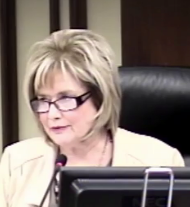 Lancaster speaking at a city council meeting on bullying. This matter is far from closed. The public interest was and is – can a member of council disclose information they gained in a Closed Session of Council without any repercussions. The fact that Ms Lancaster was not re-elected is not the issue.
It is as if the treasurer of a corporation stole some money from the corporation and then quit their job; does that mean they don’t get investigated and perhaps charged?
While the city cannot apply any sanctions against a Councillor who breaks the rules for their own benefit there are other levels of government that can.

 By Staff By Staff
January 22nd, 2019
BURLINGTON, ON
Does a delegation a citizen make have any impact on both member’s of city council and staff?
There are people who sometimes wonder.
A number of months ago a resident delegated. The city does not release the name of the citizen but in a report to Council, Jamie Tellier, Manager of Urban Design reported on a meeting with a citizen.
The concern was with the Tall Building Guidelines (TBG) the city put in place some time ago.
The issue came out of a Staff Direction from the adoption of the new Official Plan which was approved by city council, sent to the Region who sent it back due to what the Region thought were some deficiencies.
“A motion from Council arising from the adoption of the new Official Plan “Directed the Director of City Building to review the suggested changes from the delegation presentation on the tall building guidelines and report back to Council with any updates.
“This memo will serve to provide members of Council with an update on this staff direction.
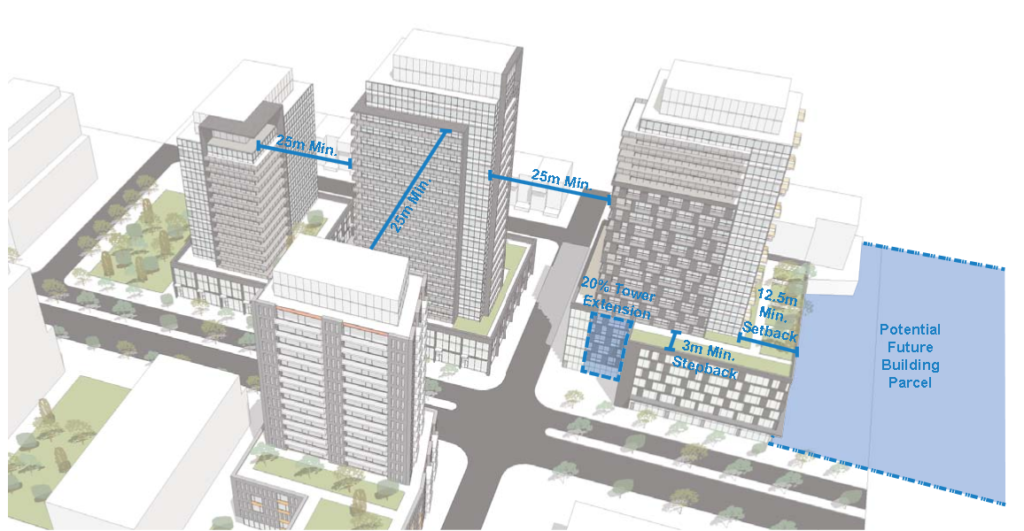 Tall building design – set backs and spacing “In September 2018, staff met with the delegate to discuss their presentation to council. This meeting allowed the delegate to share observations and to ensure staff understood the submission. The delegation to council suggested that the City of Burlington Tall Building Guidelines (TBG) did not reflect best practices with regard to sun/shadow impacts and that they did not address the issue properly. The delegation made reference to the City of Toronto Tall Building Guidelines as an example of best practice.
“There were three main areas of concern related to the guidelines:
Application of sun/shadow impacts
“The delegate reviewed the rationale component of the City of Toronto Tall Building Guidelines without the benefit of reviewing the associated detailed guidelines. Through further discussion the delegate and staff agreed that the City of Toronto and the City of Burlington TBG are virtually identical in how they deal with sun/shadow impacts.
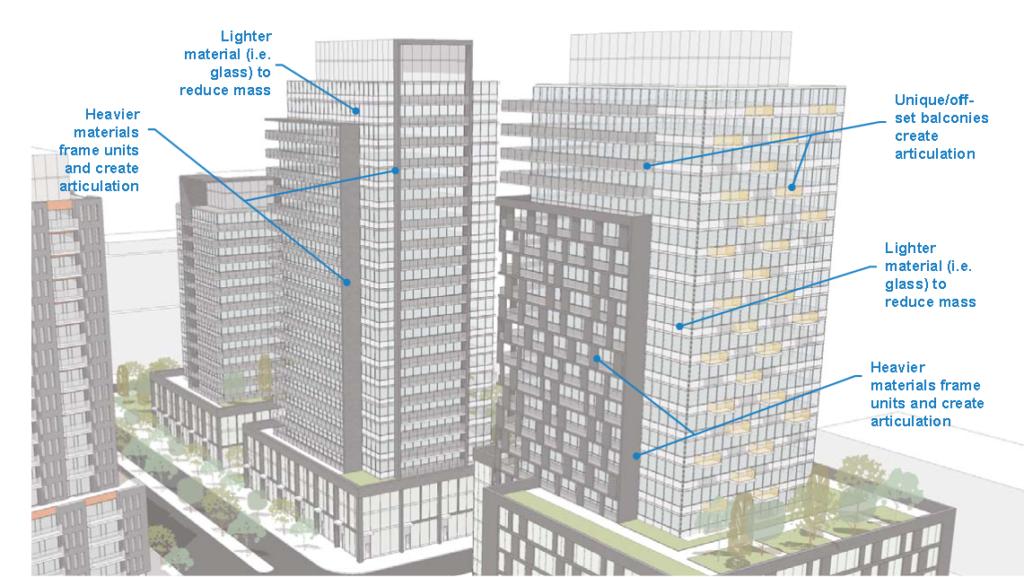 Suggested materials that would work well on tall buildings. Excluding December 21 in measuring sun/shadow impacts
“The delegate also made reference to the TBG only measuring sun/shadow impacts for five consecutive hours of sunlight on the opposite side of street during the equinoxes (March 21 and September 21) and suggested including December 21 (shortest day of year) to these measurements. Staff and the delegate discussed why the shoulder seasons are most important for evaluating sun/shadow impacts as daytime and nighttime are of approximately equal duration during the equinoxes. Not including the shortest day of the year is intentional and a reflection of municipal best practices (City of Toronto and others).
Silent on the Cumulative Effect of Shadow Impacts and Wind Effect
“Lastly, the delegation also indicated that the TBG was silent on the cumulative effect of shadowing and wind effects. Staff, in discussion with the delegate confirmed that Section 3.1.b) of the TBG requires a 25 metre separation distance between towers to minimize cumulative shadow impacts.
“Separation distances between towers along with other design guidelines such as maximum tower floor plates are commonly used techniques to manage the cumulative effect of shadows. Similarly, Section 3.2.c) of the TBG requires the building design to not have an adverse wind effect at the street level.
Next Steps:
“As a result of the above, our conversation moved away from any perceived shortcomings of the TBG and focused more on how sun/shadow and wind studies are prepared by applicants and evaluated by staff.
This was a topic on which staff and the delegate were in alignment. Staff confirmed that in 2019 the departmental work plan includes exploring the related policy structure and development review procedures as they relate to sun/shadow and wind studies. The intent is to ensure clarity and consistency in how sun/shadow and wind studies are prepared and evaluated and to improve our overall decision making processes .
“The delegate appreciated that this was on our workplan and reinforced the importance of standardized criteria to evaluate wind and shadow impacts. Staff will provide further updates later in 2019 as this initiative progresses.”
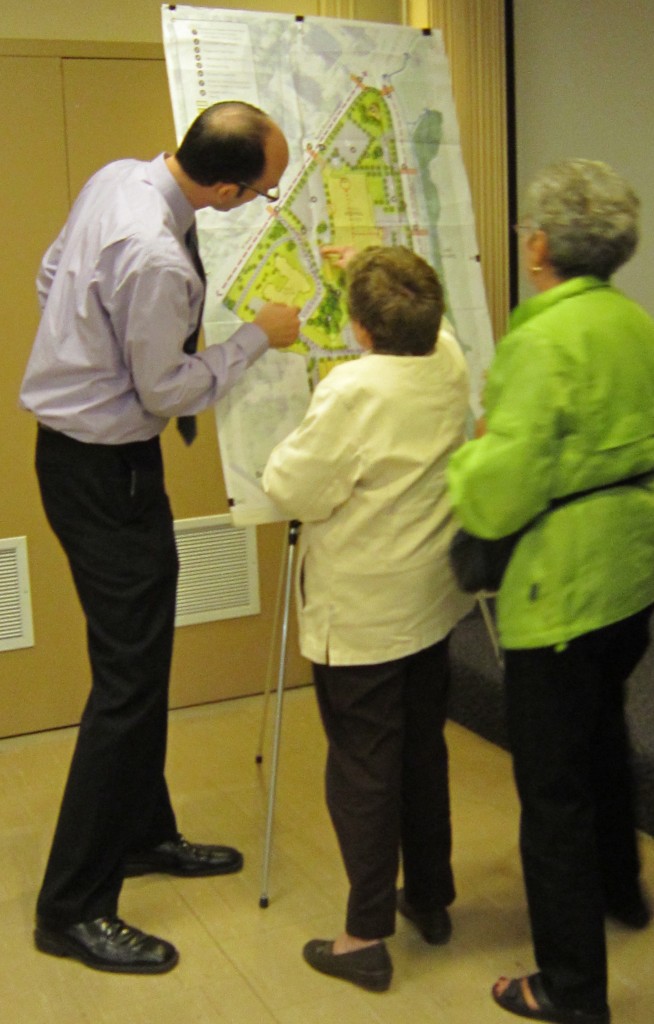 Jamie Tellier, Manager of Urban Design explains what is going to be built where on the hospital campus. Is the above a meaningful dialogue between staff and a citizen? Will anything come of it? Was the resident satisfied?
Jamie Tellier is one the best people in the Planning department when it comes to inteligently and cheerfully explaining an issue to anyone who will give him the time.
Who was the resident and what did he or she think of the process?
Can’t say – but we do know that staff listened and that the resident was given ample opportunity to make a case.
Relevant news stories published previously.

 By Pepper Parr By Pepper Parr
January 22nd, 2019
BURLINGTON, ON
When it comes to matters of property – anything is possible and almost everything happens.
National Homes has a number of development applications on the go. The large development they want to build on Brant Street is working its way through the appeal process. The city didn’t process that application within the time frame required so National Homes appealed to the OMB.
There is another application – this one on Plains Road, referred to by the locals as the “bingo hall” development because the property National Homes bought includes a bingo hall.
It also includes the Good Fortune Chinese Restaurant
 Plaza that National Homes wants to develop is the location of both a Chinese Restaurant and an illegal massage parlor. Who Knew? At a Local Planning Appeal Tribunal (LPAT) a Mr. Zan Wang applied for status as a xxx. That request was denied because the matter Mr. Wang wanted to discuss didn’t have anything to do with the development of the property. It had to do with a lease Mr. Wang had on a property on the site National Homes site.
Mr. Wang wanted to participate in the appeal but was turned down by the Chair on the grounds that Wang’s issue was a commercial matter and outside the purview of the PHC (PreHearing Conference)and hearing.
From email traffic: Wang wanted to know when the issue of the six years remaining on the lease was going to be settled; he did not speak in opposition to the development.
On January 15th, the Wang family sent an emotional email to almost every email address they could find. It said:
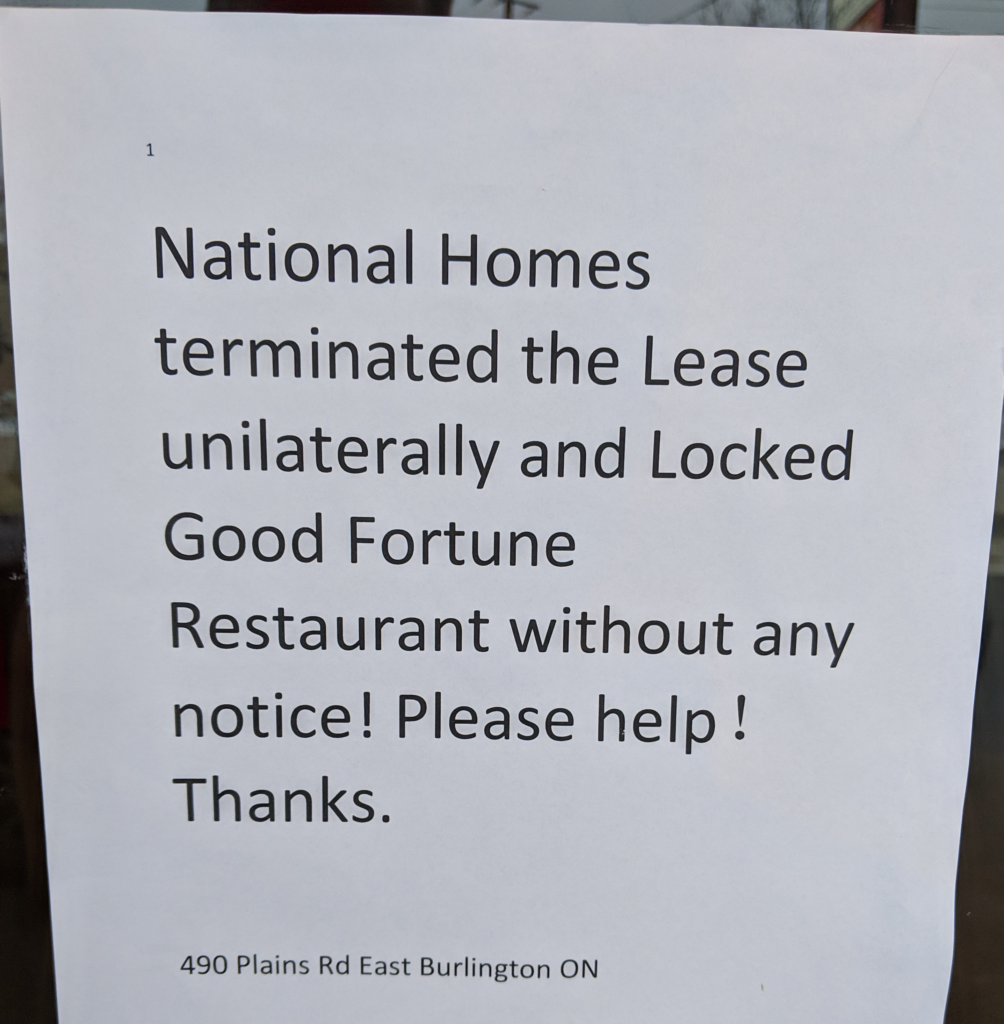 Sign placed on the door of the Good Fortune Restaurant We are the owner of Good Fortune Chinese Restaurant in Bingo Plaza (490 Plains road east). We beg for anyone help, we are hopeless.
In the pre-hearing conference (hold on December 19, 2018, at City Hall), I suggested National Home because we have a long term of lease agreement (around another 6 years) with them, so we need a reasonable solution.
Unfortunately, the National Homes used an untruthful reason locked our restaurant without any formal notice on January 1st, 2019.
We never own National Homes any rents, and we are never in default. The only reason is we signed a long-term of lease agreement at the beginning. Our family restaurant is the “Obstacle” on their way to make their “Big Dollar”. They hired a group of lawyers to attack us, and they knew we cannot afford the legal fee like they do. Our family rely on this business to live, and most our neighbourhoods know how hard we are working in our restaurant.
I want to ask everyone a question! If the National Home treat the existing tenant like this, how can they deal well with all the neighbourhood in the future?
We prepared huge amount of food for the New Year holiday; however, the National Homes locked our out on January 1st, they gave us a real life “Nightmare”.
We just beg anyone can help our family.
Wang”s family – Good Fortune Chinese Restaurant.
The action on the part of National Homes seemed a little heavy handed.
A Gazette reader told us –“ Apparently they had an illegal massage parlour open up within their premises and were asked to remove it and did not comply.
“As we frequent the restaurant regularly, we have seen for the last year or so the door leading to what was signed as Betty’s Spa and Massage. The door and window to enter, which were covered over with signage, were next to the restaurant.
“We first noticed this about a year ago but never connected it to the restaurant. There was nothing visible to suggest it was in the same premises, either from outside or inside the restaurant, although we were never in the kitchen where a connection could have been, although there appears to be a side door at the other end of the restaurant that we don’t go by that may connect, but not obviously. And there was never any mention of it from staff inside the restaurant.
 One of thousands of Chinese restaurants across the province. This one appeared to have a side line business next door. “We have been going there for four years and we never saw a connection as the massage space was empty most of that time. We didn’t know it might have been part of the restaurant premises for the lease.
Aside from that I don’t know what the covenants were on the lease. Or what process might have occurred before the termination to get them to close the massage place. There must be some paper on this.
Our reader continued: “ They may just be ignorant of what is a permitted use, covenants can say what the tenant cannot do. Maybe they thought they could use it. Not a pretty story.
“In any case, the business is basically ruined, National Homes is apparently holding them liable for costs and rents for the duration of the six year lease. Unless this is somehow overturned, NH won’t have to sue and buy out the balance of the lease remaining when the time comes. I have heard that commercial leases have teeth.”
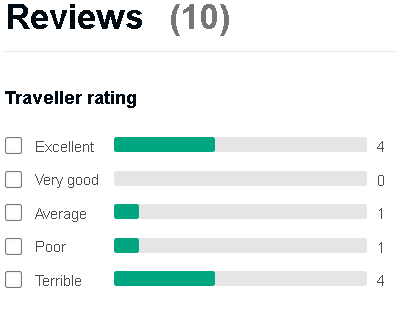 Reviews were mixed. What was being reviewed – the food or the Betty’s massage parlor? Another reader asked: “Was the “illegal massage parlour located next to the Good Fortune Restaurant in another unit or in the back of the restaurant itself? If it was located in an adjacent unit, even if it was leased by the same owner of the restaurant why would the Restaurant be closed?
“Also how long has this massage business been operating and how long has National Homes known about it?”
The pressing question is: An illegal massage parlour in Aldershot? Who knew?
And who is Betty?
And has anyone told the Tourism department? No one told the Bylaw enforcement Officer.

 By Staff By Staff
January 22nd, 2019
BURLINGTON, ON
After years of getting to the point where there would be a Private Tree Bylaw Burlington is now ready to put at least a toe in the water of a very controversial issue: can anyone just cut down a tree on their property.
The Roseland Private Tree Bylaw Pilot comes into effect March 1. Information sessions are planned.
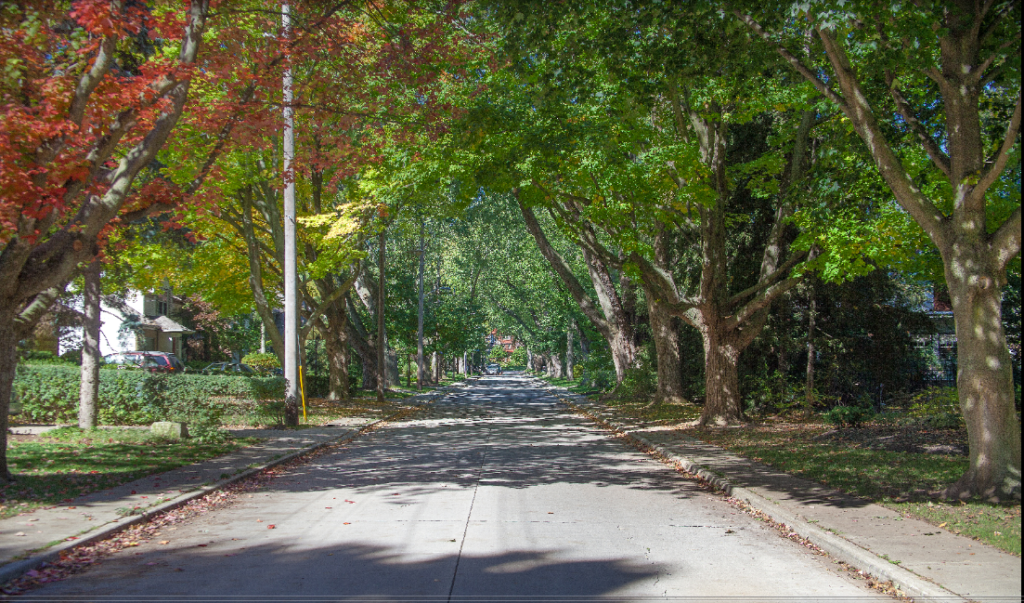 Streets can look like this as long as the owners of the property those tress are on go along with the bylaw. The pilot project aims to protect private trees with diameters larger than 30 cm, historic and rare tree species from damage or destruction.
The two-year pilot will conclude in March of 2021. At the end of the pilot, a report with recommendations will be presented to City Council.
About the Private Tree Bylaw:
No person can injure, destroy, cause or permit the injury or destruction of a tree with a diameter of 30cm or greater or of a tree of significance (historic or rare).
The full bylaw, including information on permits, exemptions and fines, visit Burlington.ca/PrivateTree.
Examples of exemptions include:
• Trees with a diameter of less than 30cm
• For the purpose of pruning in accordance with Good Arboricultural Practices
• For emergency work
• If the tree has a high or extreme likelihood of failure and impact as verified or confirmed by an Arborist or the Manager
• If the tree is dead, as confirmed by the Manager of Urban Forestry, or designate
• If the tree is an ash tree (due to the Emerald Ash Borer), as confirmed by the Manager of Urban Forestry, or designate
• If a tree is within two metres of an occupied building
• For more exemptions, visit Burlington.ca/PrivateTree
Permits you will have yo get – and pay for:
A person wanting to remove a tree with a diameter larger than 30 cm or of significance can apply for a permit online by visiting Burlington.ca/PrivateTree.
Fines for failing to comply with the bylaw:
Minimum fine is $500. Maximum fine is $100,000.
Public Information Session
Residents and businesses of the Roseland community are invited to attend a drop-in information session on the Private Tree Bylaw pilot on January 29, 2019, from 7 to 9 p.m. at the Burlington Seniors’ Centre, 2285 New St., Burlington.
 This is what Belvenia looks like now – a lot of the trees are on city property. The informal, drop-in style of session will allow residents and businesses to learn about the Private Tree Bylaw and how it will impact their homes, business and neighbourhood by speaking with city staff including members of the Forestry Department.
For those who are unable to attend, more information can be found at burlington.ca/PrivateTree.
A second information session will be held for those living and working outside of the Roseland community at a later date.
 There is a relationship between those trees and those geese. The geese were eating the apples that fell from the tree and they pooped on the church driveway – church didn’t like that – the trees were cut down. The Mayor has gone very public on this one. Marianne Meed Ward said: “As I mentioned in my inaugural address, protecting Burlington’s tree canopy is one my goals. Burlington residents feel passionately about this issue. These trees are a big part of what makes our city beautiful, and they are also important contributors to our clean air, an important part of mitigating flood risk in our neighborhoods, and they provide shelter and sustenance for countless creatures in our natural surroundings. They’re a valuable resource we need to protect.”
Mary Battaglia, Director of Roads, Parks & Forestry explains that: “Although the city is responsible for thousands of trees on its streets and in its parks and open spaces, most of Burlington’s trees are on private land which makes it so important to work with residents and other stakeholders who own or manage these properties throughout the city as they have the greatest ability to preserve and protect the city’s urban forest.”
Links and Resources
Private Tree Bylaw Pilot

 By Staff By Staff
January 22nd, 2019
BURLINGTON, ON
The Hamilton Spectator recently did a front page feature on the Freeman Station.
The “Friends” of Freeman Station said it was a “terrific article to get our message out, and we thank Jeff Mahoney for that. Now we really need your help in 2019 to gather the last bit of funding to reach our goals.
Can you help us by becoming a member?”
 “As Lord Kitchener would have said, “Please visit our website at www.freemanstation.ca/store/ ” and become a member. “As Lord Kitchener would have said, “Please visit our website at www.freemanstation.ca/store/ ” and become a member.
“Or have your name added to our wall of Whinstone donors by purchasing a stone for $100.
Prefer to come in person?
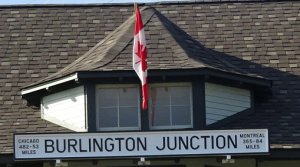 The Station will be open on February 16 2019 from 10:00 am – 1:00 pm – we invite everyone to drop by. The Station will be open on February 16 2019 from 10:00 am – 1:00 pm – we invite everyone to drop by.

 By Staff By Staff
January 21st, 2019
BURLINGTON, ON
The Provincial Offences (POA) Courts in Burlington and Milton are getting ready to relocate to one new courthouse at 4085 Palladium Way in Burlington.
The Milton POA Court relocated its services to the Burlington POA Court on Friday, January 18, 2019. On Thursday, January 31, 2019 the Burlington POA Court and all POA court services will move to the new Halton Provincial Offences Court.
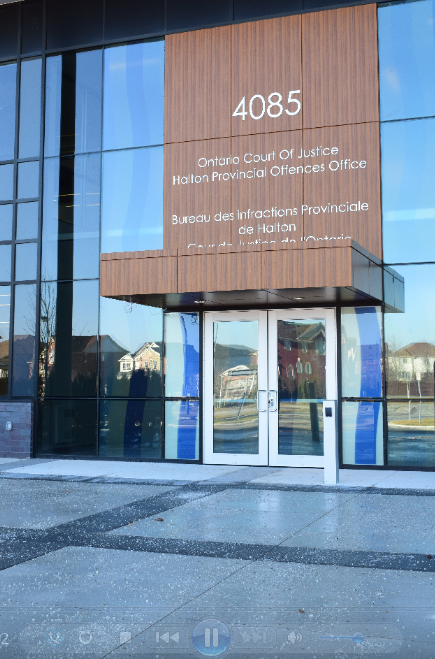 New Court House that will hear just provincial offences – will open early in February. The new, consolidated Ontario Court of Justice – Halton Provincial Offences Office will open to the public on Tuesday, February 5 and will begin hearing cases on Wednesday, February 6.
Halton Court Services is a partnership of Halton Region and four local municipalities: the City of Burlington and the Towns of Halton Hills, Milton and Oakville.
The new POA Court will administer provincial offences court services for all of Halton Region. Provincial offences court services include only non-criminal provincial offences charges issued in Halton. These non-criminal charges include:
• Highway Traffic Act offences, such as speeding, driving without insurance or failing to stop at a red light.
• Municipal bylaw offences, such as excessive noise, animal control or garbage disposal.
• Offences under provincial legislation such as the Environmental Protection Act, the Occupational Health and Safety Act, the Dog Owners’ Liability Act or the Trespass to Property Act.
Facts about the Ontario Court of Justice – Halton Provincial Offences Office
• Criminal charges, family law matters and Small Claims cases will not be handled at the courthouse.
• The new facility, at 34,000 square feet (3,159 square metres), will meet today’s needs more effectively and will
help Halton Court Services plan 30 years into the future.
• Beginning Tuesday, February 5, 2019, the courthouse will operate Monday to Friday, 8:30 a.m. to 4:30 p.m.

 By Staff By Staff
January 21st, 2019
BURLINGTON, ON
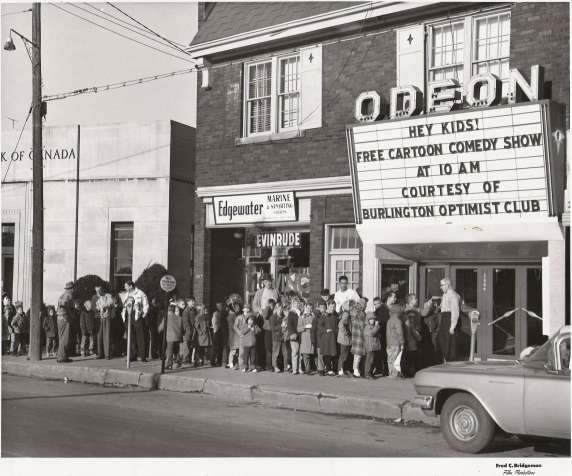 How many people in Burlington remember this theatre that was on Lakeshore Road The City of Burlington’s Heritage Committee has been busy planning another exciting Heritage Month, that begins on February 1st.
There is an opportunity to learn more about the events and issues that have shaped Burlington and Canada by attending the informative sessions planned throughout the month.
Topics and events will include Black history, First Nations, Freeman Station, Burlington architecture, movies, panel discussions, stories and more. The full calendar listing is at bpl.on.ca and burlington.ca/calendar.
 Lower kitchen in Ireland House – it is a tour well worth the time. A kick-off event is planned for Friday, February 1st at St. John’s Anglican Church, 2464 Dundas from 1 to 2 p.m and at Ireland House Museum, 2168 Guelph Line from 2:30 to 4 p.m.)
1 p.m. – Greetings from Mayor Marianne Meed Ward; talks on St. John’s Cemetery, Burlington Agriculture and Oakridge Farm
2:30 p.m. – Refreshments (hot cider and freshly baked scones) and tours of Ireland House Museum.
Seating for this event is limited so please RSVP to arabellagore@gmail.com by Jan. 25, 2019.
Someone in the audience at the Ireland House presentation might want to ask the Mayor about the house she lives in on Martha Street; The Meed Ward family went to the effort to have their home designation as historically relevant.
Howard Bohan, Chair, Heritage Burlington that made this event possible worked with the Burlington Public Library, Museums of Burlington and the City of Burlington. He gives special thanks to the Burlington Heritage Month Committee and to Martha Hemphill of the United Empire Loyalists Association for her leadership.”

 By Andrew Drummond By Andrew Drummond
January 21st, 2019
BURLINGTON, ON
Last week, the Ontario government announced a number of changes to the way the Colleges and Universities will be funded in Ontario. As with many of the changes that have been brought in by this government, these changes are short-sighted and will cause hardships that fall heaviest on the most vulnerable in our society.
The changes include:
– A 10% reduction in tuition for most undergraduate and diploma programs, with no funding to address the revenue shortfall this will create
– A reduction in the number of grants available to low income students and more stringent requirements needed to get a grant
– The end of free tuition for low income students
– A reduction in the amount of family income necessary to disqualify you from the OSAP program
– Changes to the application of interest to force students to pay back more money earlier.
Each of these changes will have different impacts and should be evaluated separately.
 In essence, what the Ford government is declaring is, a family that makes minimum wage is too rich for their kids to deserve a grant to attend college. The change the government is advertising the most is the 10% reduction in tuition fees. On its face this seems to be a positive policy change that will allow more students access to post-secondary education. When announcing it, Minister Fullerton called it “a historic moment that will better help low income…”.
However, the key to this policy is in the details of it. This reduction will cost universities and colleges $400 million per year in lost tuition revenue. When asked how the institutions would handle the reduction in funds, Minister Fullerton responded, “They will need to adapt. To innovate.” Anyone who has attended a university in the past 20 years will be able to figure out what sort of “innovations” this will entail. Larger class sizes, more part-time instructors. Colleges and universities will figure out how to do it with less, but it will come at the expense of the quality of education that students will receive.
Such action is short sighted in many different ways. If the goal of our colleges and universities is to best prepare the next generation for careers to move Ontario forward, is it not essential to protect the quality of that education? When we reduce the value of our institutions, it lowers Ontario’s ability to be competitive on both a national and international stage. The current government makes ubiquitous announcements regarding building Ontario up to be open for business. However, these actions are going to lower the quality of our future workforce, thus making Ontario less attractive for anyone looking to expand here.
Beyond the damage to the institutions themselves, the government also made it more difficult for students from lower income families to attend university. One of the most progressive policies brought forth from the previous Liberal government had been to develop a grant system by which a lower income student could receive free tuition. Now this grant system has been reduced so that is no longer possible. Additionally, the grants that remain are available only to students whose family income is less than $50,000, excluding a huge population that desperately needs this assistance.
It is worth digging deeper into exactly what the effect of lowering the threshold to $50,000 will do, and by extension what the government considers low income to be. A person making minimum wage full time earns $14 an hour. If they earn this wage 40 hours a week, their weekly earnings are $560. Multiply that by 52 weeks and a minimum wage earner working full time gets $29,120 each year (assuming they didn’t have to take any unpaid sick days). If both parents earn this amount, the family income (excluding money the student makes) is $58,240.
In essence, what the Ford government is declaring is, a family that makes minimum wage is too rich for their kids to deserve a grant to attend college.
Beyond the elimination of grants is the changes announced to the OSAP system. While there may be a compelling argument for reducing the threshold to apply from $175,000 to $140,000, it is still going to be a difficult change for some students whose parents cannot or will not help them and they will need to turn to private lenders.
Adding further damage is the announced change to the grace period before students have to pay interest on their owed loan amounts. Even Mike Harris’ government saw fit to allow a six month grace period given the difficulty most recent graduates experience in finding. This grace period is based on understanding that for youth there are struggles to break into their chosen fields and that a grace period to allow them time to start a life was necessary. Taking away the grace period and thus taking money away from recent graduates is a regressive step that will make it harder for young people to begin a career.
Taken as a whole, all of these changes amount to: lower standards for post-secondary education, increased barriers for lower income students, and more punishing requirements for students to hurt their abilities to build a life after graduation. What Ontario needs is more robust funding for better education. What we need is the removal of barriers so that every student is able to pursue education in their chosen field of study.
But most of all, what we need is a government who values these things and is looking to build Ontario for the future not cut it in the present.
 Andrew Drummond with Jane McKenna, the MPP for Burlington, Andre Drummond was the New Democrat candidate for Burlintong in the last provincial election.

 By Pepper Parr By Pepper Parr
January 18th, 2019
BURLINGTON, ON
 Director of Finance Joan Ford does a great job of providing the data ad her department does a good job of collecting the taxes as well. It’s the spending side that is causing the long term financial stress. Ms Ford doesn’t do the spending. Joan Ford, Director of Finance, has been educating the members of City Council for as long as the Gazette has been reporting in this city.
Her department is, without much doubt, the best run department in the city. Ford either has the information a council member asks for at her finger tips or she gets back to them real fast.
This year the educating of council members is a bigger job for the city treasurer; all but two of the seven are new to matters municipal.
There are just two of the new comers who have solid business experience and a demonstrated ability to work with numbers. The rest are going to have a tough time and will stumble on occasion.
Council has some hard decisions to make – the upside is that this new council is asking hard questions – they want to know if the “nice to haves” are really worth it?
Earlier in the month council asked the Finance department to tell them what would have to be taken out of the proposed budget to get either a 3.25%, or a 3% or a 2% tax increase for 2019.
They also wanted to know what the Impact would be if the 1.25% infrastructure levy were removed for 2019. Staff did respond, it wasn’t a pretty picture. That staff response will appear in another Gazette news report.
During the day long session on Thursday the finance department people set out what the challenges are.
The city created a 25 year Strategic Plan that serves as the reason decisions are made. Everything is measured against that Strategy. Along with the four “pillars” the bureaucrats added some additional targets that are more fine tuned.
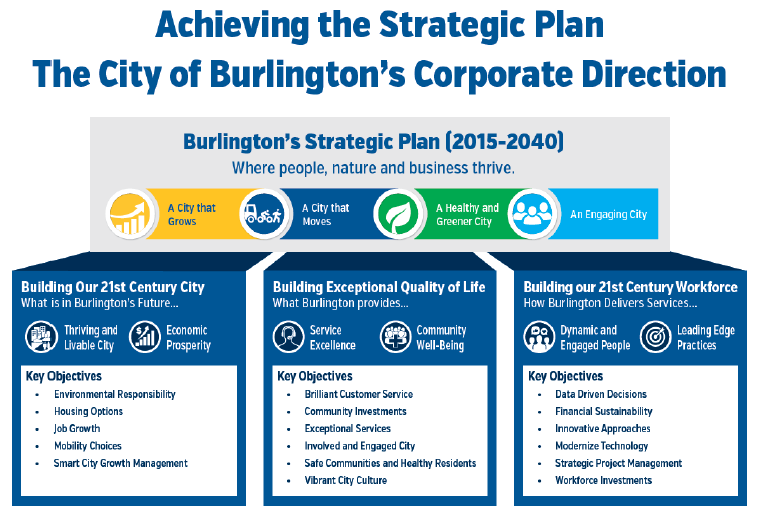 The Strategic Plan: the guide and foundational document decisions rest on.
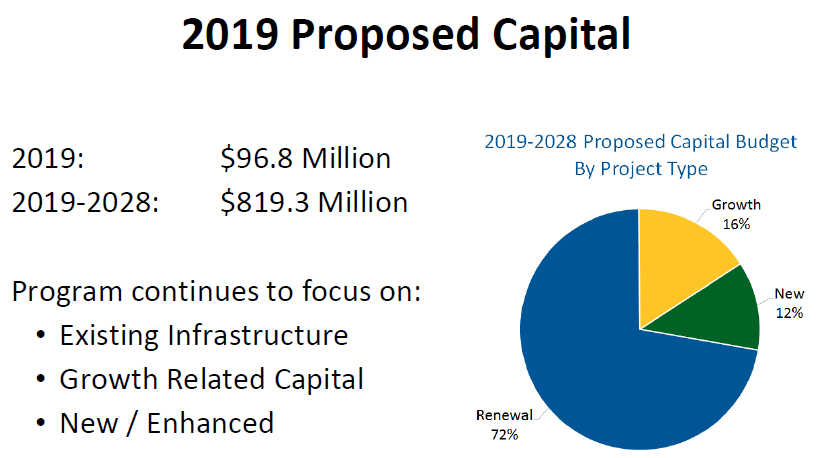
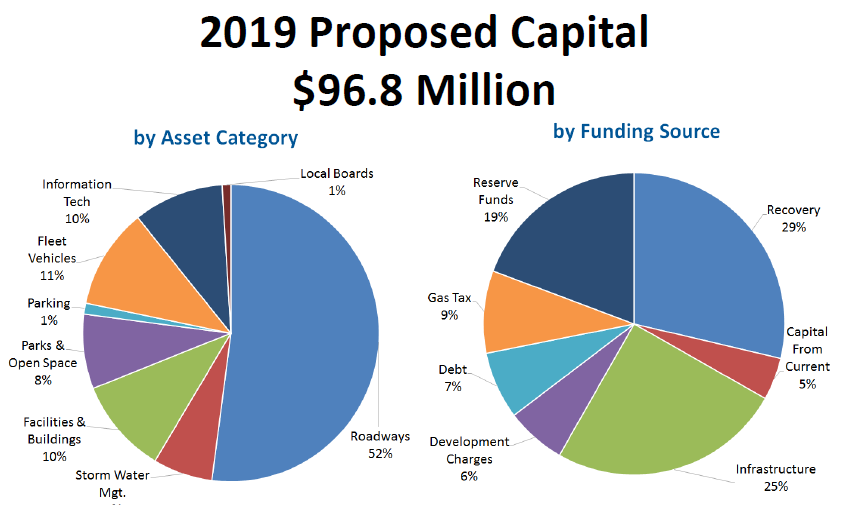
 The province permits debt up to 25% of assesment; Burlington has set 12% as its debt limit – it has in the past exceeded that for very short periods of time. The reality is- Burlington has significant capacity for additional debt – and if money continues to be cheap it might be an option.
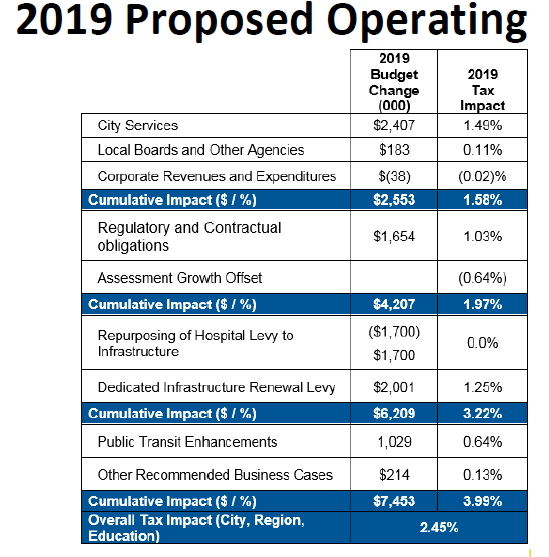 The number that matters is what the city tax bills is going to be – averaging the totals just blurs the picture.
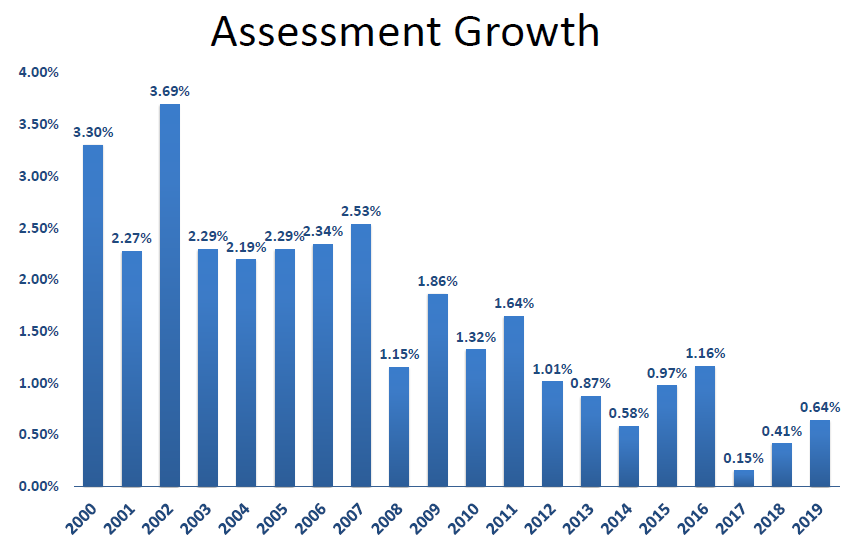 Assessment growth brings gobs of money to the city in the way of development charges. Once a development is completed the city has to take on the maintenance of the streets that were built and providing the services needed. Historically Burlington has seen impressive growth – but the city is now basically built out and for the immediate future there isn’t going to be any tax revenue from the developments in the planning stages. That reduces tax cash flow.
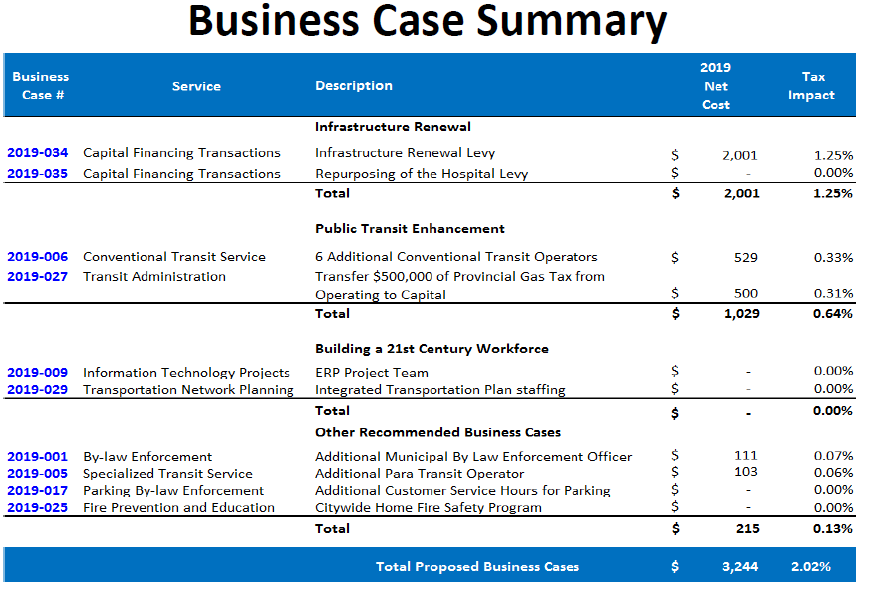 The numbers are in the 000’s The Finance department sets out a business case for a decision. Do we set aside the Infrastructure renewal levy; do we add an additional by law enforcement officer. The financial implications are set out.
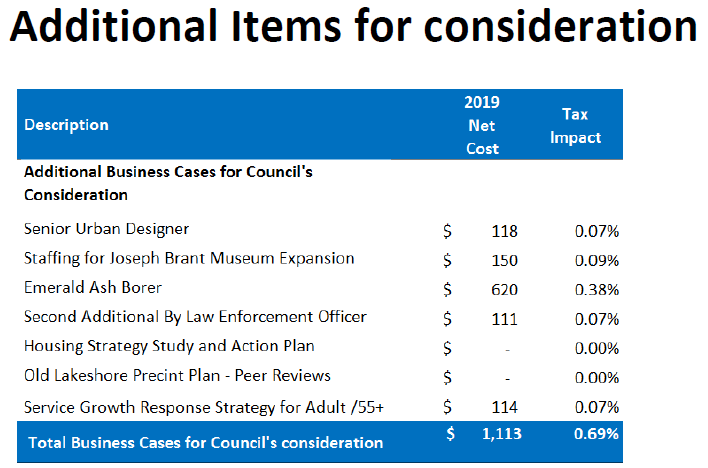 The chickens are coming home to roost at the Brant Museum: the refurbished/redesigned site will have to be staffed – there is a pin ball exhibition scheduled. Money for that is going to have to be found. Council will have to decide if they want to act on any of these. There were additional idea from staff that were not even considered by the Budget Leadership Team. 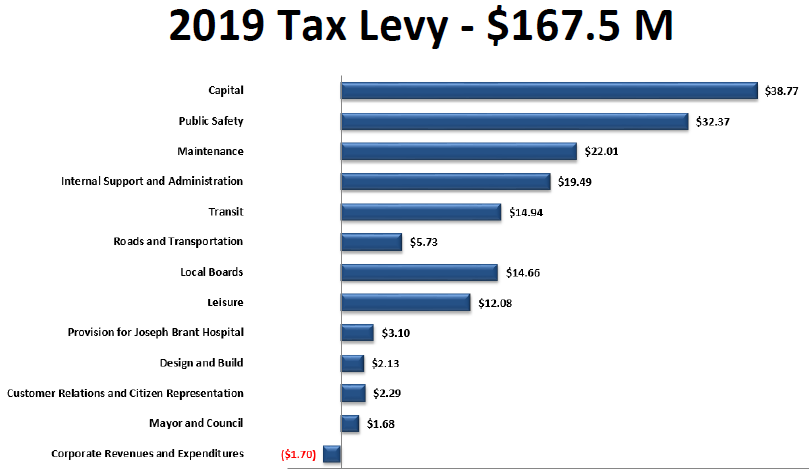 The numbers to the right of the bar graph are millions.
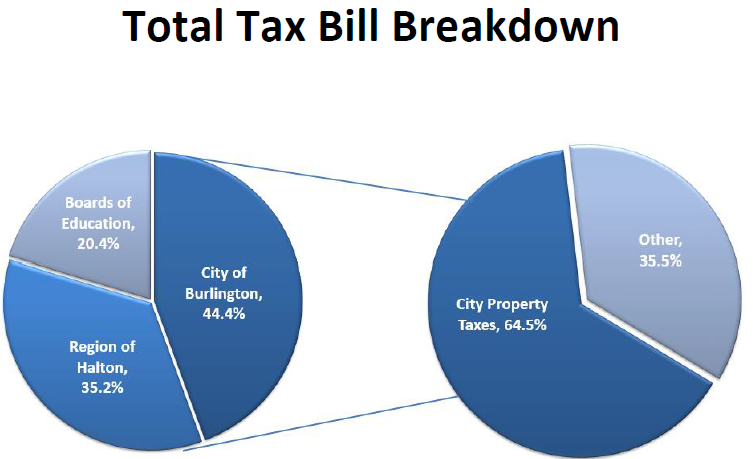 The left pie chart shows what is being collected in the way of taxes and where the tax money is going. The right pie chart shows where Burlington gets the money it needs to keep the doors open
 Every 0.5% decrease in city taxes requires $800,000 of budget reductions Translates to $1.76 per $100,000 of assessment ($8.80 / year for a $500,000 home) = 0.21% reduction to the total tax bill 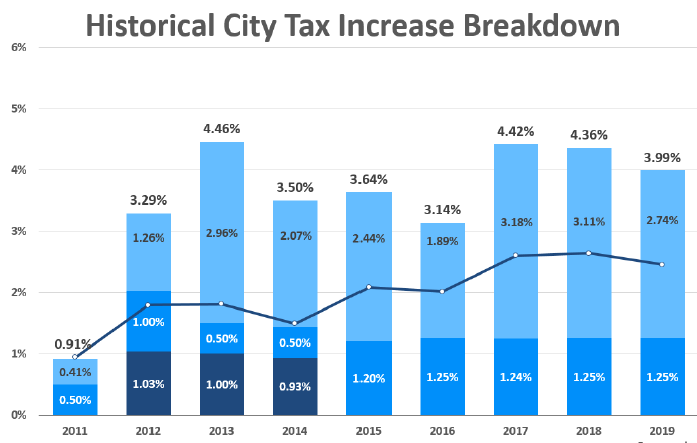 The city Council led by Rick Goldring could not manage to find a way to lower the tax bill. It was always well above inflation. The new council has taken the position that anything above inflation isn’t acceptable – now they have to figure out how to make that happen.
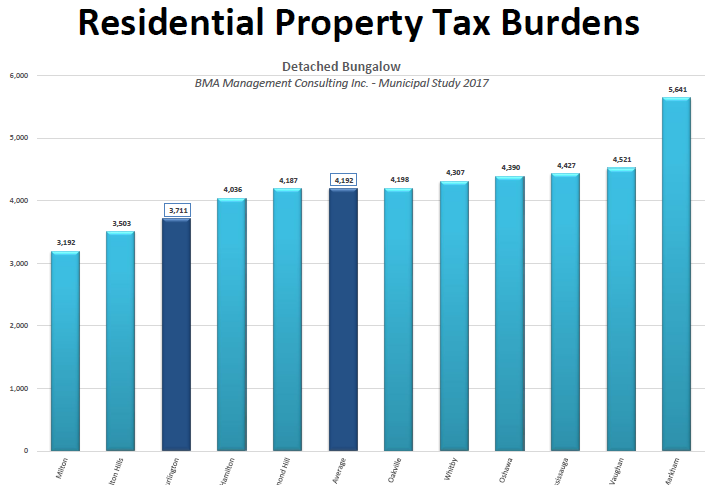 Burlington is the first dark blue bar on the left. The dark blue bar in the centre is the average for the cities surveyed. The city will know by the end of March how this new city council decides to oversee the financial side of municipal administration.

 By Pepper Parr By Pepper Parr
January 18th, 2019
BURLINGTON, ON
When Jane McKenna won the nomination as the Progressive Conservative candidate for Burlington in the June 2018 provincial election she beat Jane Michael by a slim 41 votes.
Michael appealed the vote decision arguing that she didn’t get a copy of the voters list and she wasn’t interviewed by the PC organization until days before the nomination took place.
What the public didn’t know at the time was the Ontario Progressive Conservative party officials who were vetting the candidates and doing the background screening had learned that Jane Michael failed to inform them that she had declared bankruptcy in the past.
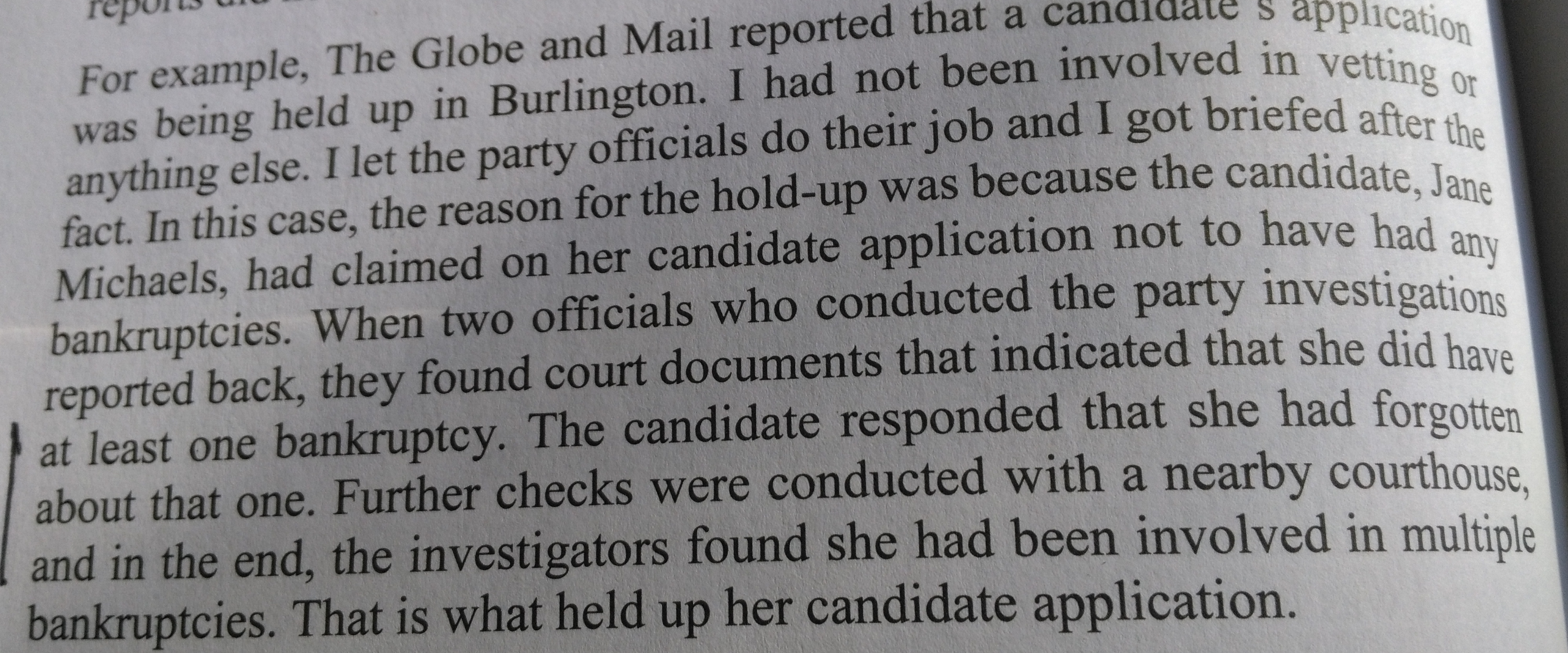 From Patrick Brown’s book: Take Down Things were quite chaotic within the PC bureaucracy at the time and they had to outsource some of the vetting – which took up a little longer than possible.
The Gazette was following the nomination squabble quite closely – and we wondered why the PC party officials were as quick as they were to reject the appeal the Michael’s team had filed. It got turned down in less than 36 hours.
That was because by that time the PC party officials had learned that there was more than one bankruptcy.
Jane Michael and her husband were in the restaurant business where bankruptcies are not unusual.
The Gazette did try on three occasions to talk to Ms Michael but were unsuccessful in having a conversation with her.
What brought the financial background to our attention was a part of Patrick Brown’s book – Take Down in which he mentions the problems with several of the nominations for the June 2017 provincial election. Ray Rivers, our political columnist, was interviewing Brown as part of a series of articles on just what had happened to Brown when he was dumped by the party as leader, got himself nominated as Chair of the Peel Regional Council; Premier Ford eliminated that position and at the 11th hour Brown filed nomination papers to run as Mayor of Brampton and won that race.
Michael was at one point the Chair of the Halton Separate school board where, June of 2016 other media reported that:
Chair of the Halton Catholic District School Board Jane Michael has accused some trustees of dissension, negativism and dishonourable conduct.
“The open mockery of our bishops, the Institute for Catholic Education as suspect, inadequate, false and questionable has been embarrassing and highly inappropriate, said Michael in response to a motion accusing her of not upholding the will of the board.
“The motion of accusation, filed by Burlington trustee Susan Trites at last night’s board meeting, was a response to Michael’s comments in the media after the board’s discipline and safety policy was defeated May 17, after previously being unanimously approved by the policy committee.
 Jane Michael “Michael was quoted as saying the board was “dragging its feet” in passing policy that was mandated by the Ministry of Education, said Trites.
“The discipline and safety policy was defeated at the May 17 board meeting and returned to the policy committee after some trustees raised concerns about the words sexual orientation and gender identity within the policy when dealing with “a safe, caring and accepting school environment.” Oakville trustee Anthony Quinn who initially raised the concerns, felt that students who “recited their Catholic teaching” could be subject to discipline under the new policy.
“I felt it was essential to respond to the media because of inflammatory motions, reversals and challenges that have not been in keeping with honourable conduct,” said Michael.
“The will of the board was definitively expressed at the board meeting when the discipline policy was sent back to committee, said Trites.
“The chair of this board failed in her duty to always state and uphold the will of the board regardless of personal opinion in all appropriate venues,” alleged Trites.
On May 17th, 2018 other media reported that:
“A Halton Catholic District School Board trustee who has been disciplined for her behaviour says she wishes she could explain what happened, but is bound by confidentiality rules.
“At a private meeting on May 8, trustees determined Burlington representative Jane Michael (Wards 3 and 6) had breached the board’s code of conduct.
“At the board’s public meeting May 15, vice-chair Paul Marai read a motion announcing the sanction and stating the penalty: Michael is barred from attending two board meetings, removed from her position on the discipline committee and excluded from the search for a new director of education “from the beginning to the end of the hiring process.”
 On August 14th, 2018 Jane Michael was acclaimed as the federal PC candidate for Burlington in the upcoming federal election expected to take place in October of 2019. On August 14th, 2018 Jane Michael was acclaimed as the federal PC candidate for Burlington in the upcoming federal election expected to take place in October of 2019.
Related news story links:
The nomination meeting Jane Michael lost was boisterous.
Rivers on the Patrick Brown interview.

 By Pepper Parr By Pepper Parr
January 18th, 2019
BURLINGTON, ON
Before they broke for the Christmas holidays a city council that had been sworn in just ten days earlier asked staff to sharpen their pencils and tell them how they would reduce the 2019 budget increase to 2%, 3% and 3.5%.
The budget they were looking at was coming in at 3.99% – and they didn’t want to have to swallow a number like that.
Council also asked staff to tell them what the impact would be of removing the 1.25% infrastructure tax levy for the 2019 budget.
Part 1 – 2019 Operating Budget Options
The options presented below largely result in decreased funding to the capital program. It is important to note that any changes to the dedicated infrastructure levy impacts both renewal projects as well as new projects in the capital program. The city’s asset management plan is about the long-term management of our existing infrastructure.
New capital assets add to the city’s base inventory and therefore increase our funding requirements for renewal needs. If we are unable to sustain our existing portfolio of assets it is recommended that we limit future expansion and/or new infrastructure. Continued investments in new or expanded assets compound our inability to financially manage our infrastructure.
Staff have provided this memo for information and have attempted to communicate the future challenges and impacts that each of the options pose.
Option A – 3.25% (0.74% tax reduction from 3.99%)

Options for service reductions are:
• Elimination of the loose-leaf collection program.
Benefits
o Ongoing operating savings of $450,000 (0.28% tax reduction) and approximately $45,000 of average annual renewal costs for the replacement of equipment.
o Allows for 2,400 staff hours to be reassigned to other program areas including parks, trails, sportsfield maintenance, and road maintenance.
o Allows for winter snow fighting equipment to be ready in November. Currently only one weekend of turnaround time between leaf collection and winter work.
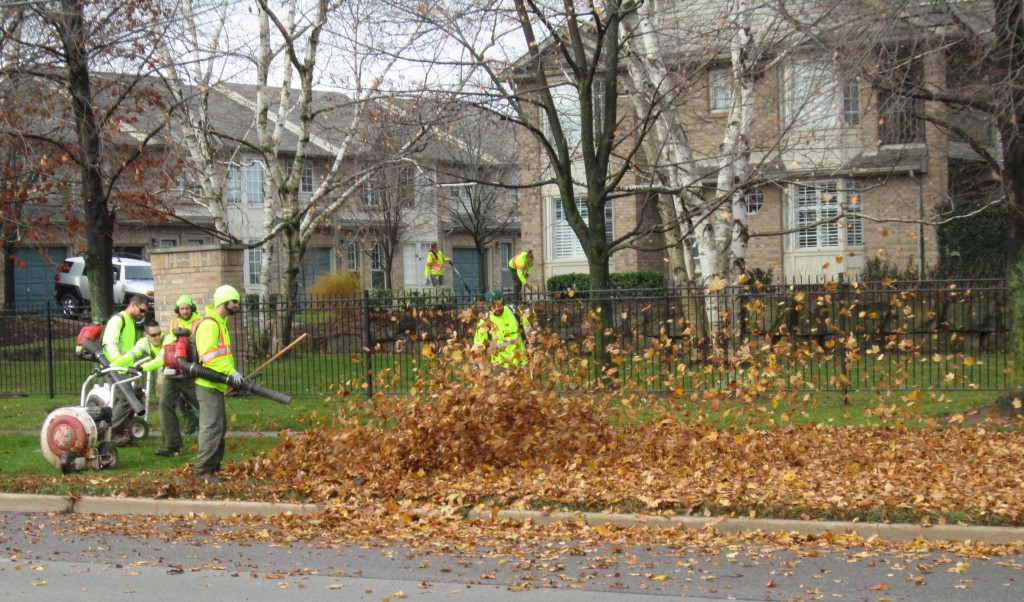 Can Burlington afford to be collecting the leaves? o Loose-leaf collection is not always completed due to onset of winter weather. This frustrates residents and challenges staff to convert equipment over to snow fighting in a timely fashion.
o Results in reduced greenhouse gas emissions from equipment operating for 6 weeks and trucking by contractor to Halton Waste Disposal site. Currently leaves are collected and trucked to a central area and later picked up by a contractor who transports them to the Halton Region transfer station where the city pays a tipping fee to dispose of the leaves.
o Halton Region provides bagged yard waste every other week from April to December.
o In lieu of this program, the city would promote more environmentally friendly options including mulching leaves on site or composting at home.
Drawbacks
o Reduced service to residents
o This will increase collection of bagged leaves by Halton Region Waste Services.
o Will require extensive public education / communication.
• 2019 capital program reduction of $750,000 for new infrastructure (0.47% tax reduction).
o Results in ongoing reduction of funding to the 10-year capital program of $7.5 million.
o The list of 2019 projects that would be impacted are:

Should this option be considered, an amendment to the 2019 capital budget would be required for the projects identified above. Future years would need to be amended as part of the 2020 capital budget.
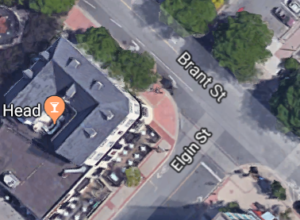 Nothing vital about putting the elimination of that right hand turn on hold. The removal of $7.5 million of funding from the 10-year capital budget and forecast would limit the city’s ability to address any requests for future new infrastructure. This would constrain future investments to implement recommendations resulting from the integrated transportation mobility plan, cycling master plan, school closure opportunities, and enhanced neighbourhood amenities such as splash pads and skate parks.
Option B – 3% (0.99 % tax reduction from 3.99%)

In addition to the items included in Option A, a further service reduction option is:
• Further reduction of $400,000 of funding to the capital program for new infrastructure (0.25% tax reduction).
o This would result in an ongoing reduction of funding to the capital program and require the removal of an additional $4 million of projects from the 10-year capital program.
o The remaining new / enhanced project meeting this dollar threshold is:

Should this option be considered, an amendment to the 2019 capital budget would be required for the projects identified above. Future years would need to be amended as part of the 2020 capital budget.
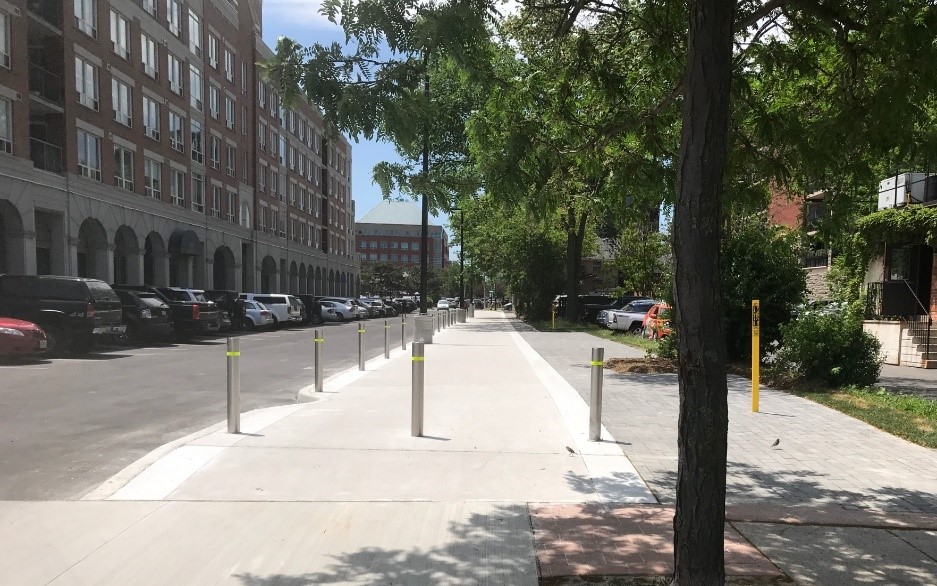 The Promenade is to stretch across the downtown core – and when that core has undergone all the high rise construction it might be something to complete – but not now. The Elgin Street Promenade is included in the Core Commitment Implementation Strategy as a short term initiative to improve active transportation in the downtown and enhance the connectivity of existing pedestrian and cycling connections to the Centennial Multi-use Pathway and the Downtown Transit Terminal through the creation of an enhanced promenade with landscaping and pedestrian facilities that meet Accessibility for Ontarians with Disabilities (AODA) guidelines. The first three phases of this project have been competed. The final phase of this project is planned for 2019 and extends from Pearl Street to Martha Street.
The completed Elgin Promenade will create a significant piece of downtown infrastructure through an east-west pedestrian and cycling corridor that provides opportunities for active transportation including cycling connections, access to transit, walkability and accessibility and brings significant social, environmental and economic benefits to the downtown core. The promenade connects the downtown to the Downtown Transit Terminal and the Centennial Multi-use Pathway which extends northeast across the City.
Without funding for this project, the final phase of this project can not be completed and the objective of connecting the east and west sides of the downtown through a safe, accessible cycling and pedestrian connection will not be realized.
Option C – 2% (1.99 % tax reduction from 3.99%)
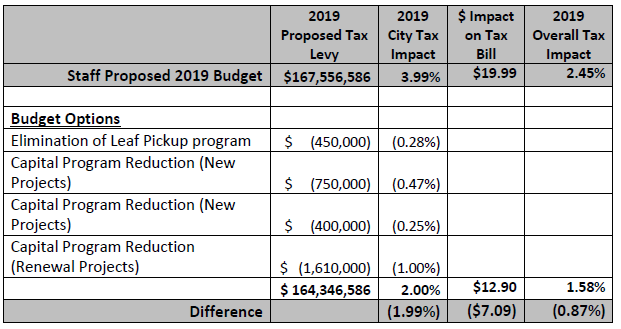
In addition to the items included in Options A & B, a further service reduction option is:
• Reduction of $1,610,000 of funding to the capital program for renewal (1% tax reduction).
o This would result in an ongoing reduction of funding to the capital program and require the removal of $16.1 million of renewal projects from the 10-year capital program.
Should this option be considered, an amendment to the 2019 capital budget would be required for the projects identified above. Future years would need to be amended as part of the 2020 capital budget.
The Asset Management Plan is built on the premise of being able to address the city’s infrastructure needs at the right time in the asset’s life cycle and in the most cost-effective manner. This is vital to ensure that city assets continue to provide a standard of service that residents expect and to minimize long-term costs.
Resurfacing a road at the optimum time results in a cost of 1x. Delaying this treatment begins to compromise the base materials, escalating costs to 3x the original value. Further delay results in the street requiring full reconstruction at a cost of 10x the original value. Removal of funding to the local road resurfacing program will result in sub-optimal timing of construction and cost escalation.
Deferring the renewal of community centres will also result in an increase in the total long-term costs to the City. This includes increased operating and maintenance costs as the facilities age as well as increased risk of system failures impacting service delivery. Recent examples of emergency facility closure include Appleby Ice Centre in December of 2018 and Nelson Outdoor Pool in the Summer of 2017.
Part 2 – Impact of removing 1.25% infrastructure tax levy
Staff interpreted the direction to include the impact for the 2019 budget year only with future dedicated levy increases continuing.
At a high level, the impacts associated with any reduction or removal of the dedicated infrastructure levy includes:
• Impact on the city’s asset management financing plan and the city’s ten-year capital program. Removing the 1.25% dedicated infrastructure levy for 2019 removes the equivalent of $2 million of capital projects (renewal/ new) in the budget year, and $20 million worth of capital projects over the ten-year capital program as the levy has a cumulative impact
• The removal of one year of funding leads to an unsustainable funding plan.
• An increase to the city’s unfunded renewal needs, meaning a backlog of renewal projects beyond the 2016 amount of $126.5 million that will require immediate attention. It is important to recognize that it is possible for the Unfunded Renewal Needs (URN) to grow to a point where the possibility of tackling the immediate requirements and continuing to keep pace with current needs will not be possible due to capacity constraints and unreasonably high financing requirements.
• Deferred maintenance and deferred renewal is inevitable. The result will be an increase in the total long-term costs to the City of Burlington by way of;
o increased operating and maintenance costs to prolong the life of the asset from accelerated infrastructure deterioration
o Increased rehabilitation costs due to deterioration beyond the life of the asset
o Escalation of capital costs due to required higher cost rehabilitation treatments
o Emergency, unscheduled maintenance due to system failures impacting service delivery
o Passing costs to future generations to manage existing assets
• Infrastructure renewal investment is crucial to replacing and upgrading assets to better adapt to climate change
There is a considerable amount of room to get a budget that is very close to inflation. It will take some courage for these council members – but they asked what was possible and staff set out what will be lost if the proposed budget is changed.
Do we really have to have the leaves picked up? Does the Fire Department really need a drone? Does that right hand turn elimination need to be done now – and why would we spend a dime on the Promenade when the downtown core is going to begin to become a decade long construction site in the not too distant future.

 By Ray Rivers By Ray Rivers
January 17th, 2019
BURLINGTON, ON
Ray Rivers has been writing on just what did happen to former Conservative party leader Patrick Brown who got ousted from the political party he led.
This, the third of a four part series is based on an interview he had with Patrick Brown.
 Brown’s book is a refreshing tell-all which goes beyond just reporting his version of events, to provide an insight into the dirty side of our democracy. The degree of corruption which plagued the provincial Progressive Conservatives in the run up to the 2018 election is shocking. Claims of ballot stuffing, fake voter ID and fraudulent voting are the kinds of tales we expect to hear about elections in the banana republics, not as an inherent aspect of Ontario’s natural governing party trying to govern itself. Brown’s book is a refreshing tell-all which goes beyond just reporting his version of events, to provide an insight into the dirty side of our democracy. The degree of corruption which plagued the provincial Progressive Conservatives in the run up to the 2018 election is shocking. Claims of ballot stuffing, fake voter ID and fraudulent voting are the kinds of tales we expect to hear about elections in the banana republics, not as an inherent aspect of Ontario’s natural governing party trying to govern itself.
Losers in nomination battles regularly complain about some kind of cheating – it was never their fault they lost, of course. But what went on with the Conservatives last year was remarkable. Patrick Brown had been leader for less than three years but his accomplishments were spectacular. Converting a seven million dollar debt to a $4 million war chest and multiplying party membership more than tenfold were not insignificant feats. But he obviously didn’t see this coming.
By the end of 2017 the party was leading the governing Liberals by 20 points in most polls. There was no question that Brown and his party would make up Ontario’s next government and if you wanted to be sure of a seat in the next legislature you needed to be a Tory candidate. It would be like having a winning lotto ticket in your pocket and a government pension in the bank.
Instead of the usual couple of hundred candidates looking to be their party’s nominee, there were something approaching a thousand interested PC candidates. And the party was unprepared for the onslaught. Most critically, the vetting of candidates to weed out the criminals, liars and weirdos had to be contracted out, slowing down the process even more, particularly when there were issues of accuracy and honesty.
 Jane Michael That became a problem for Burlington candidate Jane Michael’s, according to Mr. Brown. Her approval as a candidate was held up because she had falsely indicated that she’d never had a bankruptcy, when in fact she’d had several. In the end she was given a green light regardless. But the nomination was messy and, having lost, she filed an appeal to the party based on all the many irregularities her team had witnessed in that contest.
The party felt they could not uphold her appeal given how she had completed her nomination form. Interestingly, she was subsequently acclaimed as Burlington’s federal Conservative candidate for the upcoming election this October. Could it be that lying and bankruptcy are à la mode after Donald Trump won the US presidency?
Then there were the fixers, Snover Dhillon in particular, a convicted fraudster who had been a strong supporter of Mr. Brown. He acted as a middle man for candidates, scaring up new members and whatever else he needed to do to win the nomination for those candidates willing to pay him. He was active in as many as twenty riding associations; chaos and voting irregularities seemed to follow him everywhere.
Brown mostly stayed away from the messy competitive and troublesome nomination battles, showing up mainly at the acclamations. He admitted that he regrets not just appointing even more candidates, something that Mr. Ford, his successor, ended up doing.
One of Brown’s acclamations was Brian Mulroney’s daughter Caroline. She was reluctant to run in a downtown Toronto riding, so Brown found her another one. Mulroney was on-side with Brown’s policies including retaining the existing sex-education curriculum and implementing the federally mandated carbon tax. After all her father had been recognized as Canada’s most environmental PM.
 Caroline Mulroney – had no trouble totally reversing her positions when Mr. Ford offered her a senior cabinet post. But she had no trouble totally reversing her positions when Mr. Ford offered her a senior cabinet post and made her responsible to battle the federal government on the carbon tax. One could call that another victory for opportunism over ethics.
Another Brown recruit, now the province’s environment minister, Rod Phillips, slid into his job by also abandoning any commitment he had held to the most efficient way of fighting global warming.
Brown is a red Tory, in the style of Bill Davis, Jean Charest and to a lesser extent Brian Mulroney. His vision is of a modern progressive conservative party, the big umbrella which accommodates most of the people of Ontario. He had little tolerance for yesterday’s fights against LBGTQ, same sex marriage and abortion as he tried to make his party more like the ‘progressive’ in its name.
But if he represented the mainstream among PC membership, the most vociferous and loudest voices were those of the special interests. There are the religious right-wing radicals, like former leadership candidate Tanya Granic Allen, intent on keeping children ignorant of their own sexuality, and wanting to help us speed up a man-made hell on earth by banning renewable energy.
And there were the neo-cons, those who fancy themselves as libertarians and/or social conservatives who would like to turn the clock back. The mere mention of refugees and immigration in general would cause their necks to redden even more. Disciples of dishonoured trickle-down economics, they forever lobby for lower taxes for the rich and less welfare for the poor. Most see a future where all regulation, aka red tape, is eliminated. That is unless it serves to protect the wealthy or powerful and their style of life.
 Brown proved to be fleet of foot – locked out of Peel he ran for Mayor of Brampton and won. Brown is now a municipal politician which limits any involvement he might want to have in his former political party. And in any case that political party has disappeared in everything but name. Doug Ford’s party has no place for a progressive. And most of those influential in the current caucus were part of the very crowd that stabbed the knife in Brown’s back. There are others who are either afraid to speak up or happy to compromise their integrity to stay in power.
The book in which he ‘told-it-all’ has closed the door for him on that chapter of his career.
After only half a year in power Ford is still enjoying his honey moon. But buyer’s remorse is always around the corner when someone as charismatic and divisive as Doug Ford becomes the new emperor. Still, he has a solid majority of MPPs to allow him to do what he wants for the next four years, regardless how they got elected; this is not the first time we’ve seen corruption in a political party. One only has to recall the Liberal sponsorship scandal.
Patrick Brown doesn’t lay the blame on the ugly nomination process for the coup over his leadership and for his ultimate banishment from the Tory caucus. Clearly it didn’t help that he made enemies, but these nominations always result in disappointments even if the rules are actually followed. Brown says he loves his new job as mayor and has his hands full managing the city of Brampton.
Still nobody should think he’s resigned himself from an even grander ambition.
To be continued….
Ray Rivers writes regularly on both federal and provincial politics, applying his more than 25 years as a federal bureaucrat to his thinking. Rivers was once a candidate for provincial office in Burlington. He was the founder of the Burlington citizen committee on sustainability at a time when climate warming was a hotly debated subject. Ray has a post graduate degree in economics that he earned at the University of Ottawa. Tweet @rayzrivers
Related news stories:
Rivers on Brown – part 1; the political take-down.
Rivers on Brown – part 2; He said – she said.
Background links:
Brown’s Book – Burlington Nomination – Jane McKenna –
Michaels’ Appeal – Federal Tories – Michael Censured –
Nomination Messes – Ugly Messes – Police Investigation –
Brown Law Suit – Caroline Mulroney –

 By Pepper Parr By Pepper Parr
January 17th, 2019
BURLINGTON, ON
Some useful background when city council gets to talking about what they want to do with the “approved” Official Plan now that it has come back from the Region.
Jane McKenna, the MPP for Burlington said recently that she has “received a few emails from residents about the pace of high-rise development in our downtown.
 Burlington MPP Jane McKenna “Many are concerned about the intensification in the downtown core and the mobility hub designation that is part of Burlington’s official plan. (The one that was adopted by the city but not yet approved by the Region).
Some suggested the mobility hub designation was coupled with the approval, through the appeal process, of tall buildings in the downtown area.
McKenna talked to staff at the Ministry of Municipal Affairs and Housing (MMAH) for clarification about the legislation.
“The first thing I learned is that “mobility hubs” are identified by Metrolinx’s regional transportation plan, but do not have to be reflected as such in any local planning documents.
“The growth plan for the Greater Golden Horseshoe, 2017, does not refer to mobility hubs. The City of Burlington council is free to remove these mobility hub designations from the local official plan.
Burlington might be able to remove mobility hub designations but there isn’t a hope in hades that Burlington will move away from the concept of hubs which are understood to be locations where development is increased and transportation options intensified.
The City’s Planning department is well into some deep dive research and with precincts defined and mapping work done showing where different heights and density of residential will be located. Plans for additional park space are also well advanced.
McKenna has muddied the waters with her comments. There will be three mobility hubs; one at each of the existing GO stations.
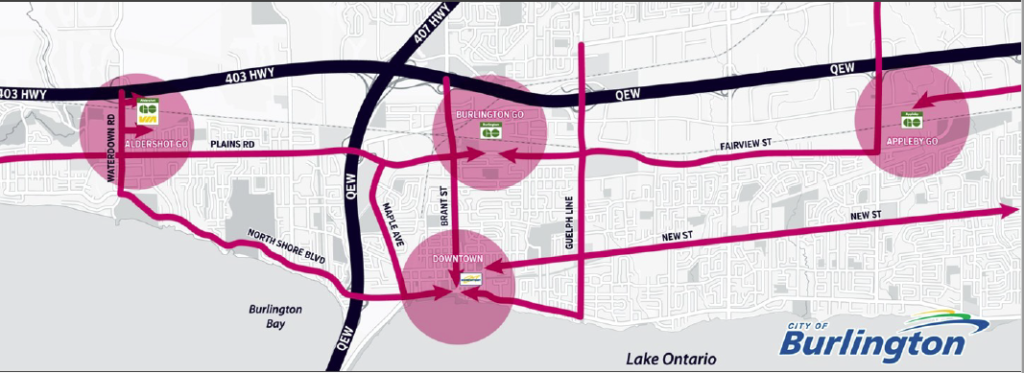 The mobility hubs at the GO stations are a fact. Nothing is going to change that. The Downtown mobility hub’s long term existence has yet to be determined by the new city council The continued existence of a Downtown Mobility Hub is in doubt. City Council will debate that at some length when they get to that matter.
The creation of a downtown mobility hub and the loss of an OMB hearing that should not have ben lost has done significant damage to the kind of downtown core residents voted against in the October election. The challenge for this council is to find a way out of that mess.
She adds that: “The growth plan for the Greater Golden Horseshoe, which was reviewed and updated in 2017, identifies downtown Burlington as an urban growth centre and sets a specific growth target.
“It also identifies the Burlington GO station as a major transit station area and sets a growth target. These are required elements of all official plans because higher densities are necessary to justify transit infrastructure investment.
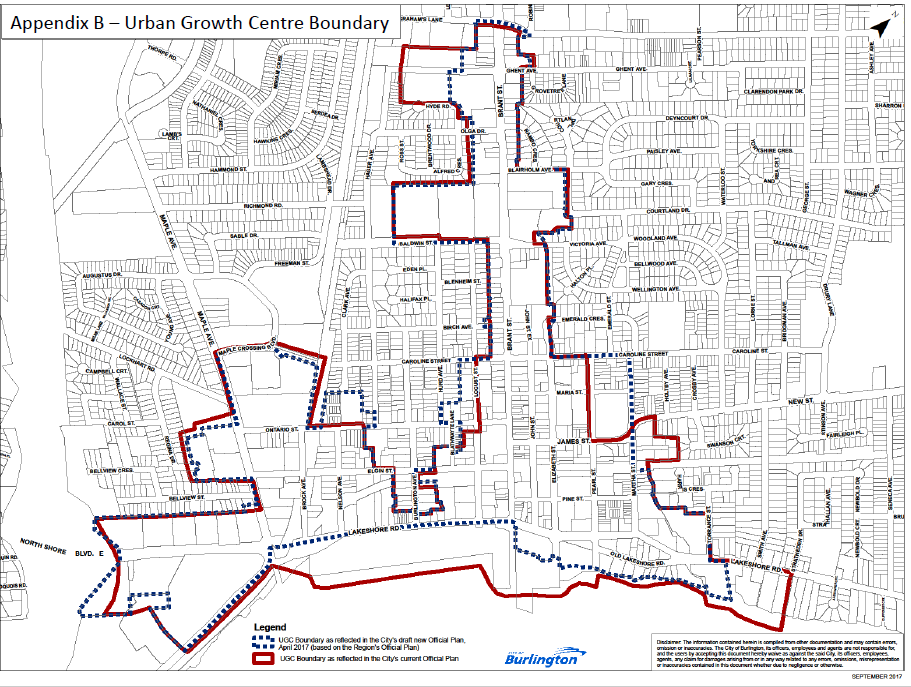 The Urban Growth Centre boundary may well get revised when city council tackles that issue. “That brings me to the second important point I took away from my discussion with MMAH. If city council voted to change the boundaries of the downtown Burlington urban growth centre this could be accomplished by Halton Region as part of the next official plan review.
“This must take place prior to July 1, 2022. Burlington could then, in turn, amend its official plan to reflect the new boundaries.
“Although boundary changes are allowed, the growth plan does not permit the removal of the urban growth centre designation. Changes would need to be approved by the Ontario government as part of the approval of Halton Region’s official plan amendment.”
 MPP McKenna wrapped her Christmas parade float in Tory blue – she will play that card as long as she can and hope that it keeps her in office. 
 By Staff By Staff
January 17th, 2019
BURLINGTON, ON
 What we all once knew at the Burlington Mall is now the Burlington Centre. What we all once knew at the Burlington Mall is now the Burlington Centre.
It is going to take more than the odd mention to get that name to stick. The Performing Arts Centre tried for several years to make that name people would use for what we know as the Performing Arts Centre.
The trades training school(s) operated as an arm’s length part of the Halton District School Board are using the name for their operation on the South Service Road and in the facilities they have in Oakville.
Nevertheless the Centre people are giving it the old college try in their efforts to make the location a destination.
The Centre people worked with the Burlington Fine Arts Association to create THE HUB – a brand new space at the Burlington Centre where the BFAA will be holding their Juried Show, the first of many planned exhibits.
 The space is warm and intimate and we are proud to say that we were consulted on the design to make it “art friendly”. A hanging system was installed and portable walls specially designed for artwork were purchased. The space is warm and intimate and we are proud to say that we were consulted on the design to make it “art friendly”. A hanging system was installed and portable walls specially designed for artwork were purchased.
Join the BFAA for their opening reception and awards presentation Friday, January 18th @7pm. Or drop by the Hub between January 18th and 28th to view the exhibit and vote on the People’s Choice Award.
You could win a $100 gift certificate from the Burlington Centre.

 By Pepper Parr By Pepper Parr
January 17th, 2019
BURLINGTON, ON
Local Boards and Committees are to be given a 2% increase over their 2018 base budget.
 The group consists of the Library, the museums, the Art Gallery, Performing Arts, Tourism and the Economic Development Corporation. The group consists of the Library, the museums, the Art Gallery, Performing Arts, Tourism and the Economic Development Corporation.
Is there going to be a council member who stands up and say “Let’s make that 1.5%” Some belt tightening at the Boards and Committees is about due. These groups have been handed 2% almost automatically for the past decade.
If we are asking city hall to pull in the belt a notch or two – the same could and should be asked of the Boards and committees.
 The city can expect to hear for more in the way of funding for the Museum. The re-launched Joseph Brant Museum is going to have its hand out for more in the way of funds to staff the new digs. The city can expect to hear for more in the way of funding for the Museum. The re-launched Joseph Brant Museum is going to have its hand out for more in the way of funds to staff the new digs.
Get ready for the grand announcement sometime when the frost comes out of the ground of the opening exhibit – an exhibition of pin ball machines.
 Little wonder that Joseph Brant’s body was carried to Brantford and buried there; he would roll over in the grave he had in Burlington if he knew what they had done to his Burlington homestead. Little wonder that Joseph Brant’s body was carried to Brantford and buried there; he would roll over in the grave he had in Burlington if he knew what they had done to his Burlington homestead.
Salt with Pepper reflects the views, musing and opinions of the publisher of the Gazette

|
|
 By Pepper Parr
By Pepper Parr



































 Ray Rivers writes regularly on both federal and provincial politics, applying his more than 25 years as a federal bureaucrat to his thinking. Rivers was once a candidate for provincial office in Burlington. He was the founder of the Burlington citizen committee on sustainability at a time when climate warming was a hotly debated subject. Ray has a post graduate degree in economics that he earned at the University of Ottawa. Tweet @rayzrivers
Ray Rivers writes regularly on both federal and provincial politics, applying his more than 25 years as a federal bureaucrat to his thinking. Rivers was once a candidate for provincial office in Burlington. He was the founder of the Burlington citizen committee on sustainability at a time when climate warming was a hotly debated subject. Ray has a post graduate degree in economics that he earned at the University of Ottawa. Tweet @rayzrivers The session on Monday was the first opportunity the new Council got to see what it was that they had to live by.
The session on Monday was the first opportunity the new Council got to see what it was that they had to live by. On September 20th, Ward 6 Councillor Blair Lancaster posted a note on the Facebook page of what is known as Burlington News.
On September 20th, Ward 6 Councillor Blair Lancaster posted a note on the Facebook page of what is known as Burlington News.














 “As Lord Kitchener would have said, “Please visit our website at www.freemanstation.ca/store/ ” and become a member.
“As Lord Kitchener would have said, “Please visit our website at www.freemanstation.ca/store/ ” and become a member. The Station will be open on February 16 2019 from 10:00 am – 1:00 pm – we invite everyone to drop by.
The Station will be open on February 16 2019 from 10:00 am – 1:00 pm – we invite everyone to drop by.






















 On August 14th, 2018 Jane Michael was acclaimed as the federal PC candidate for Burlington in the upcoming federal election expected to take place in October of 2019.
On August 14th, 2018 Jane Michael was acclaimed as the federal PC candidate for Burlington in the upcoming federal election expected to take place in October of 2019.







 Brown’s book is a refreshing tell-all which goes beyond just reporting his version of events, to provide an insight into the dirty side of our democracy. The degree of corruption which plagued the provincial Progressive Conservatives in the run up to the 2018 election is shocking. Claims of ballot stuffing, fake voter ID and fraudulent voting are the kinds of tales we expect to hear about elections in the banana republics, not as an inherent aspect of Ontario’s natural governing party trying to govern itself.
Brown’s book is a refreshing tell-all which goes beyond just reporting his version of events, to provide an insight into the dirty side of our democracy. The degree of corruption which plagued the provincial Progressive Conservatives in the run up to the 2018 election is shocking. Claims of ballot stuffing, fake voter ID and fraudulent voting are the kinds of tales we expect to hear about elections in the banana republics, not as an inherent aspect of Ontario’s natural governing party trying to govern itself.





 What we all once knew at the Burlington Mall is now the Burlington Centre.
What we all once knew at the Burlington Mall is now the Burlington Centre. The space is warm and intimate and we are proud to say that we were consulted on the design to make it “art friendly”. A hanging system was installed and portable walls specially designed for artwork were purchased.
The space is warm and intimate and we are proud to say that we were consulted on the design to make it “art friendly”. A hanging system was installed and portable walls specially designed for artwork were purchased.
 The group consists of the Library, the museums, the Art Gallery, Performing Arts, Tourism and the Economic Development Corporation.
The group consists of the Library, the museums, the Art Gallery, Performing Arts, Tourism and the Economic Development Corporation. The city can expect to hear for more in the way of funding for the Museum. The re-launched Joseph Brant Museum is going to have its hand out for more in the way of funds to staff the new digs.
The city can expect to hear for more in the way of funding for the Museum. The re-launched Joseph Brant Museum is going to have its hand out for more in the way of funds to staff the new digs. Little wonder that Joseph Brant’s body was carried to Brantford and buried there; he would roll over in the grave he had in Burlington if he knew what they had done to his Burlington homestead.
Little wonder that Joseph Brant’s body was carried to Brantford and buried there; he would roll over in the grave he had in Burlington if he knew what they had done to his Burlington homestead.




